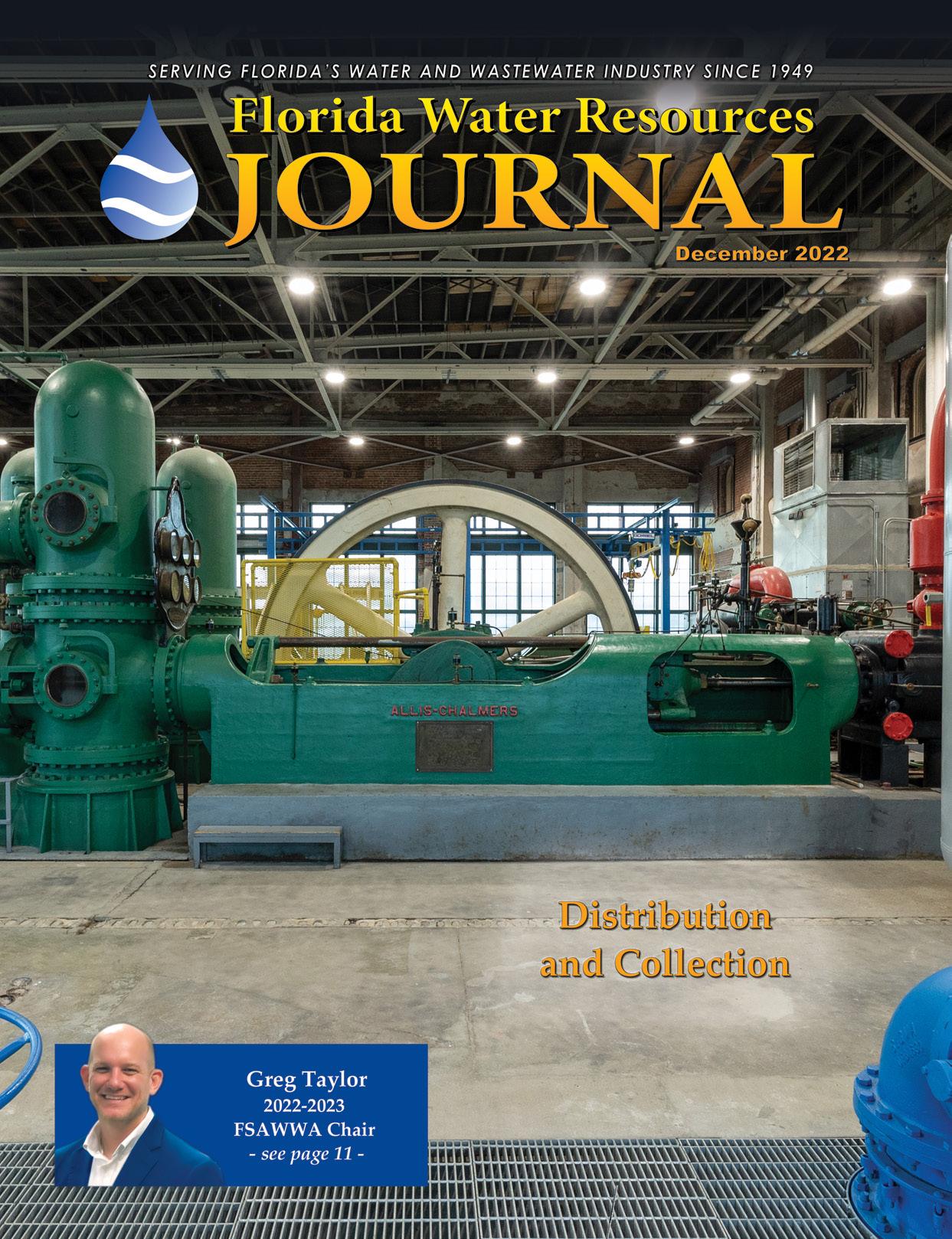


Experience, Expand, Evolve with ZeeWeed* 500 The next generation of superior MBR technology for large municipal MBR applications The ZeeWeed 500 series has expanded with its innovated ZeeWeed 500EV configuration. Addressing the ever-changing need of municipal customers looking to: 415 Country Club Drive Winter Park, FL 32789 www.heywardfl.com *Trademark of Veolia; may be registered in one or more countries. ©2022 Veolia. All rights reserved. Reducing the Total Cost of Ownership with Innovation Longer membrane life means fewer membrane replacements Reduce membrane tank footprint by up to 50% Best available technology for water recycling Lower energy usage by 20% and reduce chemical consumption
Editor’s Office and Advertiser Information:
Florida Water Resources Journal
1402 Emerald Lakes Drive
Clermont, FL 34711
Phone: 352-241-6006
Email: Editorial, editor@fwrj.com
Display and Classified Advertising, ads@fwrj.com
Business Office: 1402 Emerald Lakes Drive, Clermont, FL 34711 Web: http://www.fwrj.com
General Manager: Michael Delaney Editor: Rick Harmon
Graphic Design Manager: Patrick Delaney Mailing Coordinator: Buena Vista Publishing

Published by BUENA VISTA PUBLISHING for Florida Water Resources Journal Inc.
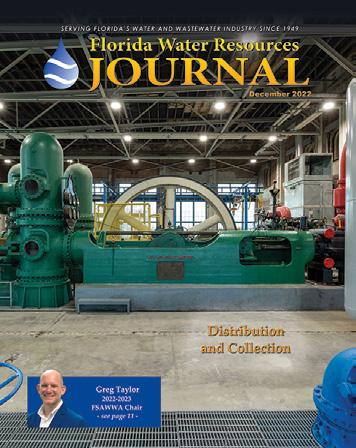
President: Richard Anderson (FSAWWA) Peace River Manasota Regional Water Supply Authority
Vice President: Jamey Wallace (FWEA) Jacobs
Treasurer: Rim Bishop (FWPCOA) Seacoast Utility Authority
Secretary: Mish Clark Mish Agency
Moving?
The Post Office will not forward your magazine. Do not count on getting the Journal unless you notify us directly of address changes by the 15th of the month preceding the month of issue. Please do not telephone address changes. Email changes to changes@fwrj.com or mail to Florida Water Resources Journal, 1402 Emerald Lakes Drive, Clermont, FL 34711
Membership Questions
FSAWWA: Casey Cumiskey – 407-979-4806 or fsawwa.casey@gmail.com
FWEA: Karen Wallace, Executive Manager – 407-574-3318
FWPCOA: Darin Bishop – 561-840-0340
Training Questions
FSAWWA: Donna Metherall – 407-979-4805 or fsawwa.donna@gmail.com
FWPCOA: Shirley Reaves – 321-383-9690
For Other Information
DEP Operator Certification: Ron McCulley – 850-245-7500
FSAWWA: Peggy Guingona – 407-979-4820
Florida Water Resources Conference: 407-363-7751
FWPCOA Operators Helping Operators: John Lang – 772-559-0722, e-mail – oho@fwpcoa.org
FWEA: Karen Wallace, Executive Manager – 407-574-3318
Websites
Florida Water Resources Journal: www.fwrj.com
FWPCOA: www.fwpcoa.org
FSAWWA: www.fsawwa.org
FWEA: www.fwea.org and www.fweauc.org
Florida Water Resources Conference: www.fwrc.org
USPS 069-770, ISSN 0896-1794,
34711, on behalf of the Florida Water & Pollution Control Operator’s
Florida Water Resources Journal, Columns 6 FWEA Focus—Sondra W. Lee 10 C Factor—Patrick “Murf” Murphy 20 FWRJ Reader Profile—Ben Yoakum 22 Let’s Talk Safety—Working at Altitude: Don’t Fall Into Danger 24 FSAWWA Speaking Out—Emilie Moore 40 Test Yourself—Donna Kaluzniak 41 FWEA Chapter Corner—Get Involved With the FWEA Students and Young Professionals Committee!—Nicole Cohen Departments 48 Classifieds 50 Display Advertiser Index ON THE COVER: The original 1-mgd engine-driven Allis-Chalmers pump located at JEA’s Main Street Water Treatment Plant that previously served downtown Jacksonville. For more information, go to page 14. (photo: Samuel Vargas) Volume 73 December 2022 Number 12 Florida Water Resources Journal • December 2022 3
is published monthly by Florida Water Resources Journal, Inc., 1402 Emerald Lakes Drive, Clermont, FL
Association, Inc.; Florida Section, American Water Works Association; and the
Water
receive
publication as
service of their
$6 of membership dues support the Journal. Subscriptions are otherwise available within the U.S. for $24 per year. Periodicals postage paid at Clermont, FL and additional offices. POSTMASTER: send address changes to Florida Water Resources Journal, 1402
Lakes
4 Julianne
8 Register Now
11 Greg
19 Florida
34 Process Page—Babcock Ranch: A Community With a Focus on Sustainability—Al Mitrovic 43 WR3 Seminar in 2022 Shines Brightly in City of Plant
Throughout this issue trademark names are used. Rather than place a trademark symbol in every occurrence of a trademarked name, we state we are using the names only in an editorial fashion, and to the benefit of the trademark owner, with no intention of infringement of the trademark. None of the material in this publication necessarily reflects the opinions of the sponsoring organizations. All correspondence received is the property of the Florida Water Resources Journal and is subject to editing. Names are withheld in published letters only for extraordinary reasons. Authors agree to indemnify, defend and hold harmless the Florida Water Resources Journal Inc. (FWRJ), its officers, affiliates, directors, advisors, members, representatives, and agents from any and all losses, expenses, third-party claims, liability, damages and costs (including, but not limited to, attorneys’ fees) arising from authors’ infringement of any intellectual property, copyright or trademark, or other right of any person, as applicable under the laws of the State of Florida. Kevin Carter 46 WWEMA Elects 2023 Officers and Directors 46 News Beat Technical Articles 14 A Model to Identify Future Treatment Needs to Minimize Disinfection Byproduct Formation— Ryan Popko, Emory Gawlik, Todd Mackey, Dave MacNevin, Yanni M. Polematidis, and Anna Ness 32 An Innovative Septic Phaseout Program—Josefin Hirst, Damann Anderson, and Michael Dvoroznak Education and Training 12 Florida Water Resources Conference 27 CEU Challenge 28 FSAWWA Fall Conference Attendee Thank You 29 FSAWWA Fall Conference Regional Sponsors Thank You 30 AWWA Member Thank You 31 FSAWWA Member Thank You 39 FWPCOA Training Calendar
Florida
Envi ronment Association. Members of all three associations
the
a
association;
Emerald
Drive, Clermont, FL 34711 News and Features
LaRock and John Trofatter Receive WEF Volunteer Service Recognition Awards
for the 2023 Florida Water Resources Conference Contests!
Taylor to Lead FSAWWA in 2022 -2023
Student Receives AWWA Woodard & Curran Scholarship
City!—
Julianne LaRock and John Trofatter Receive WEF Volunteer Service Recognition Awards
2010 WEF Public Education Award in the individual category.
Juli currently works as a section administrator in the water quality bureau of the South Florida Water Management District. Previously, she served as a consulting engineer providing industrial, civil, and environmental engineering services in Guam, the Marianas, and Micronesia. She’s had a diverse career, working as an industrial engineer with Walt Disney World, the U.S. Air Force at Patrick Air Force Base (AFB) in Florida, the Hickam AFB in Hawaii, and as the former deputy base civil engineer at Andersen AFB in Guam. Juli holds a bachelor of science degree in industrial engineering from the University of Florida and a master of engineering in civil engineering from the University of South Carolina.
other committees as well, and is a past Committee Leadership Council chair and vice chair. He is also a member of the New England Water Environment Association (NEWEA), the Florida Water Environment Association (FWEA), and a past member of the Michigan and New York WEAs.

John is the director of business development for Teledyne Water and is responsible for the strategic development activities of its products and services. He has more than 40 years of experience in the development and application of instrumentation and control systems in water-related industries working in a variety of capacities, including executive management, sales, product development, project management, and engineering. John attended City College of New York for electromechanical engineering.
Have you ever seen a Water Environment Federation (WEF) member sporting a gold lapel pin shaped like a torch with the signature blue WEF “W” on it? These rare pins signify a recipient of the WEF Volunteer Service Recognition (VSR) Award, which recognizes members who significantly contribute to the successes and achievements of WEF through service on a WEF committee or the house of delegates (HOD). To receive a pin, the awardee must be nominated, and then selected, by a WEF committee or the HOD. All recipients are recognized (and pinned) at the WEF Technical Exhibition and Conference (WEFTEC).

During WEFTEC 2022, held in October in New Orleans, two long-term WEF members from Florida were recognized: Julianne “Juli” LaRock and John Trofatter. Juli was nominated by the WEF Public Communication and Outreach Committee and John by the Committee Leadership Council. Their awards bring Florida’s VSR recipients to a total of five since the award was created in 2017.
Award Recipient Backgrounds

Julianne LaRock
Julianne LaRock, a licensed engineer in Florida, Guam, and the Northern Marianas, is a past chair of both the WEF and FWEA Public Communication and Outreach committees. She has been an active volunteer since the mid1990s, serving on numerous subcommittees and projects. She was also the recipient of the
John Trofatter
John Trofatter is a past member of the WEF board of trustees and has been a WEF member since 1989. He became engaged with the Operations Challenge competition in 2001, starting as a collection systems event judge and eventually assuming the roles of collection systems event coordinator and Operations Challenge Committee vice chair and chair.
John is a member of the WEF Collection Systems Committee and active with numerous
While Julianne and John are exceptional volunteers, outside of work and volunteering, Juli leads a club for Volkswagen enthusiasts in Palm Beach County and John spends his free time traveling, or with his family, especially his grandchildren.
The FWEA congratulates Juli and John on their VSR awards! Be sure to look out for the VSR pins to recognize other past recipients
4 December 2022 • Florida Water Resources Journal
Julianne LaRock
Volunteer Service Recognition Award pin.
John Trofatter
Collection System Advancements
Sondra W. Lee, P.E. President, FWEA

When it comes to collection systems, it seems that very few people would ever state that they miss the “good old days.” Gone is the time of tossing buckets outside of windows; now we can use technologies to manage our collections systems. These systems have come a long way and will continue to advance as more is learned about, and developed, for improved, economical ways to collect sewage and deliver it to treatment facilities.
Areas of Expertise
For such a simple concept, there are many areas of expertise within the topic of collections systems. This is really evident when you review a presentation lineup at conferences, seminars, or workshops.
For example, utilities should have a master plan to keep an eye on the big picture, considering where collection systems may need to be expanded, or where there may be areas that need to convert from septic tanks to centralized sewer. In addition to determining phasing of projects and selecting methods of conveyance (e.g., pressure versus gravity), each utility must make difficult decisions based on budgeting constraints. With the recent escalation of construction costs, prioritization of these needs becomes immensely important.
Implementing projects in areas already developed introduces another set of skills and needed tools. Having a good data base of existing underground infrastructure is incredibly helpful during both the design and construction phases. Note that utilities would be wise to capture the knowledge of their longterm field crews in some sort of document. Planners and designers need to continually learn about other alternative construction methods for implementing new collections systems, like using trenchless technologies to reduce the impact to communities.
The number of technologies for maintaining a collection system has really grown over the years. These range from
maintenance programs that utilize staff, rehabilitation methods, and hardware and software/firmware options. Every utility should stay on top of its asset management programs, especially now with multiple reporting requirements.
There are plenty of options and sources available to assist utilities with asset management programs. A small utility might get away with just using a spreadsheet, while other utilities may run their programs inhouse with an enhanced software package, or with the assistance of a consulting firm. Whichever method is used, utilities really do not have an excuse for not having a plan that works for them.
Another challenge for utilities may be the funding of new technologies. It would be wise to have someone on the team who can prepare business case evaluations to demonstrate the costs and benefits of purchasing these tools. It’s likely that smart technologies will continue to improve and possibly become more affordable for utilities and consultants to overcome other challenges facing collection systems, such as pump station and piping rehabilitations, climate resilience, storm management, and power supply.
The Other Advancement: Outreach
Public outreach is another tool available to extend service life and capacity, in addition to reducing maintenance. Utility management would benefit by teaming up with its marketing department, or setting aside funds for hiring firms, to assist with public outreach efforts. Notifying communities about ideal locations and types of tree plantings, and education on how to dispose of oils, wipes, and other objects, should lead to a reduction in reactive maintenance. Encouraging water conservation would also be beneficial to prolong the capacity of a collection system.
In recent years, the wastewater industry has also been reaching out to firms that produce personal wipes. Through workshops and healthy, constructive conversations, a few firms have stopped advertising their products as “flushable.” Another option to help nudge the industry is to seek out and purchase only those products that have removed the term “flushable” from the packaging. So, perhaps if the word “flushable” is printed on that facial tissue box or personal wipes package, it should
be placed back on the shelf and not purchased. Hopefully, another brand can be found that is properly labeled that can be selected for purchase.
Collections Seminars and Committees
There are several ways to get more involved or to learn more about collections systems. For example, the Water Environment Federation (WEF) is planning a Collection Systems Conference in June 2023 in Kansas City, Mo. If interested, abstracts, session proposals, and workshop proposals can be submitted until December 6. More information is available on the conference webpage at www.wef.org/ events/conferences/upcoming-conferences/ collectionsystems.
For a Florida focus, the FWEA Collection Systems Committee is a great source. This committee educates and informs the wastewater industry about trends in collection system design, management, operation, and maintenance. It does this through the development of conference programs, training materials, and seminars. The next Collection System Seminar will take place on Feb. 22, 2023, in Pinellas County.

The committee also offers training for the National Association of Sewer Service Companies (NASSCO) certification in pipeline, lateral, or manhole assessment certification programs (PACP, LACP, and MACP). The goal of these programs is to help pipeline system owners create comprehensive databases to properly identify, plan, prioritize, manage, and renovate their assets based on condition evaluation.
In addition, the committee has been working on an outreach program to encourage students to consider a career path in the water industry.
To learn more about any of these programs, or to provide sponsorship to the committee, visit www.fwea.org for more information. S
6 December 2022 • Florida Water Resources Journal
FWEA FOCUS
All wastewater treatment plants are not alike. That’s why plant designers prefer our Raptor® line of screening products, the innovative all-in-one units that screen, wash, convey and dewater screenings efficiently, capturing more fine solids and long fibers than other available screens. Raptor® products are adaptable to a wide range of configurations, giving you more choices for better performance in your unique application. They are preferred among plant operators for their simple operation, ease of use, and minimal maintenance. When performance counts, count on the industry leader for more than 90 years—Lakeside Equipment Corporation.
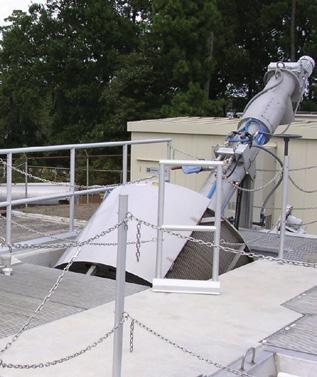

Raptor® Screening Products

Fine Screen
Micro Strainer
Rotating Drum Screen
Septage Acceptance Plant
Septage Complete Plant
Complete Plant

Multi-Rake Bar Screen
FalconRake® Bar Screen
Rotary Strainer Screen Wash Press

WE TAILOR OUR SCREENING EQUIPMENT TO FIT YOUR NEEDS.
All trademarks owned by Lakeside Equipment Corporation. © 2022 Lakeside Equipment Corporation. Cleaner Water for a Brighter Future® Speak to one of our experts at 630.837.5640, email us at sales@lakeside-equipment.com, or visit www.lakeside-equipment.com for more product information. REPRESENTED LOCALLY BY: Florida Panhandle Only T: 205.424.7570 www.eshelmancompany.com Trippensee Shaw, Inc. T. 863.382.2101 www.TrippenseeShaw.com
Register Now for the 2023 Florida Water Resources Conference Contests!

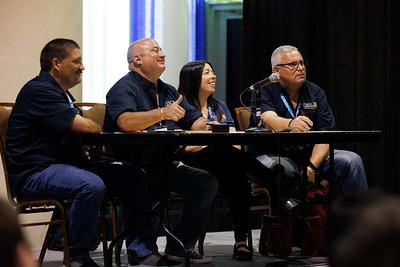


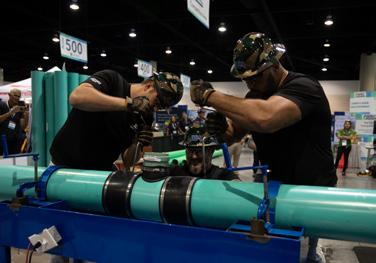
Participants are encouraged to sign up for the Operations Challenge and Top Ops competitions, which will be held at the Florida Water Resources Conference in Kissimmee from May 31 through June 3, 2023, at the Gaylord Palms Resort.
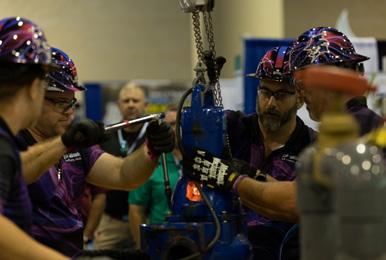
Operations Challenge
Treatment plant operators from across Florida will compete in the annual Operations Challenge. Participants will be timed in five separate operational competitions to determine the state’s representative for the national
Operations Challenge at WEFTEC 2023 in Chicago.
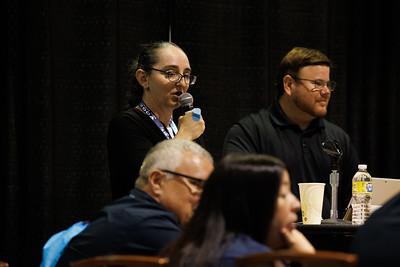
The contest promotes team building, leadership, education, and pride within a utility. Any utility that didn’t have a team in the 2022
contest is especially encouraged to participate in next year’s event.
For information and entry forms, contact Chris Fasnacht, Operations Challenge chair, at 407-254-7224.
The annual statewide Top Ops contest will also be held at the 2023 conference. Top Ops is the “College Bowl” of the water industry. Teams of one, two, or three water operators or laboratory personnel from the FSAWWA regions compete against each other in a fast-paced question-andanswer tournament at the conference.
A moderator poses a wide range of technical questions and math problems, and the team scoring the most points in the final round is awarded the Florida Section AWWA Top Ops championship. The winning team will earn a trip to next year’s American Water Works Association
Top Ops Competition
(AWWA) Annual Conference and Exposition (ACE23) in Toronto, where it will compete with
teams from other sections in the national Top Ops contest.
Utilities throughout the state are encouraged to enter. Teams do not have to consist of employees of the same utility, and multiple utilities can sponsor a team.
No video, audio, or digital recordings will be allowed during the competition. For registration forms, more details, and to receive the competition rules, contact the Top Ops Committee chair, Andrew Greenbaum, at 352667-4138 or at agreenbaum@regionalwater.org, or visit www.fsawwa.org/topops. S
8
Florida Water Resources Journal • December 2022 9
Distribution and Collection
Patrick “Murf” Murphy President, FWPCOA
hope everyone enjoyed a wonderful Thanksgiving and was able to find a turkey for their dinners. I’ve heard a few times that there is a turkey shortage. I also wish everyone happy holidays; seems like this year was the fastest one ever.
Does Time Fly?
Can you believe it’s been 15 years already since mandatory certification for water distribution operators came into effect? After Oct. 15, 2007, completion of an approved water distribution course and passing of the state of Florida distribution examination were required to be eligible for licensure.

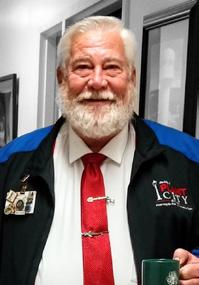

Sadly, at a short school 35 years ago I recall listening to the leaders of FWPCOA discussing and pushing for mandatory certification for distribution system and collection system operators. A motion was made and passed at the Aug. 24, 1986, board of directors meeting for the Systems Operator Committee to formulate a petition and resolution
supporting mandatory certification for system operators. The Jan. 17, 1987, meeting brought a motion (made and failed) to accept the bill as written.
Because I was a member of Region 10 at that time, and Katie Kinloch was FWPCOA’s president in 1989 and 1990, I remember that she went to speak with the house and senate committees (scared, but “willing and able”) and with the Florida League of Cities, which was only worried about certification causing cities to pay their operators more. On Nov. 3, 1991, a motion passed that, despite the position of the Florida League of Cities on mandatory certification of system operators, FWPCOA would continue its activities in pursuing the mandatory certification for system operator personnel.

On June 6, 1992, the board of directors voted to change the name “field technicians” to “systems operators.” We had excellent FWPCOA presidents waging the mandatory certification fight for years.
The federal Safe Drinking Water Act amendments, which passed Congress in August 1996, initiated the draft water/wastewater operator certification program transfer legislation. Provisions were proposed by FWPCOA; one was mandatory continuing education units (CEUs). Chapter 62-699, F.A.C., required that, beginning on May 1, 2011, suppliers of water shall employ only persons appropriately licensed under Chapter 62-602, F.A.C., to be in onsite charge of any water distribution system operation or maintenance activity that may affect water quality or quantity and that is listed in Footnote 1 under the tables in subparagraphs 62-699.310(2)(f)1 and 2, F.A.C.
The water distribution system categories for systems connected to Class A, B, or C water treatment plants were broken down as follows:
S Level 1 serving 100,000 or more persons
S Level 2 serving at least 10,000 persons and less than 100,000 persons
S Level 3 serving at least 1,000 persons and less than 10,000 persons
S Level 4 serving less than 1,000 persons
Rewriting the Song
In regard to this situation, the title of the song “How Long Has This Been Going On” should be changed to “How Long Will This Going On.”
The association has been providing voluntary certification for collection system operators for as long as I can remember. Looking through the policy and
C FACTOR
procedures manual, then-President Richard Stenberg reported at the June 14, 1997, board of directors meeting that the Education Committee would meet within three weeks to address standardization, instructor credentials, course pricing, venue specifications, and frequency and decision-making authority for the voluntary certification programs.
It was also reported at that meeting that the Florida Department of Environmental Protection (FDEP) would be in contact with the Department of Business and Professional Regulation (BPR) in Tallahassee to discuss the plant operator certification program transfer. A representative from FDEP reported that the organization would be working on an agreement to authorize BPR to manage the August 1997 certification exams, and that five positions from BPR would be transferred to FDEP, along with program funds. So, a structure for voluntary certification of collection system operators has been in place for awhile, and may not have been one of the first voluntary certification programs. That certification included water distribution systems, stormwater management, utility customer relations, reclaimed water distribution, and, most recently, utilities maintenance. This structure could have been utilized to help advance employees, and increase their knowledge and pay incentives for doing so.
The fact that the distribution system and collection system operators were deemed less important and neglected across the United States for years (along with poor asset management) and, in general, had even worse pay scales for these boots-on-the-ground operators who are paid less than drinking water and wastewater plant operators, is still an ongoing sin. They are essential personnel, and yet they never get mentioned during pandemics or disasters.
Instead of promoting mandatory certification for collection system operators (which would be costly to cities) and establishing an advancement program that should provide decision-making employees to operate and manage collection systems, it’s just easier to issue consent orders and fines for sanitary sewer overflows (SSOs). A hot-stove approach always works better, right? A balanced budget and keeping ratepayers happy are always best, right?
A very intelligent operator I work with informed me that there will be a shortage of canned tuna—you should stock up on it now if you can. According to another, climate change is causing the shortage of water—will that change the slogan “no operators, no water” to “no water, no operators”?
I promise to reflect on my attitude about a so-called operator shortage and how long it takes to make changes before I write further columns.
Keep that water clean and work safe! S
Greg Taylor to Lead FSAWWA in 2022-2023
On Nov. 30, 2022, Greg Taylor became the 97th chair of the Florida Section American Water Works Association (FSAWWA) at the section’s Annual Fall Conference. He succeeds Emilie Moore.


Greg is the Florida water group leader and a senior project manager with WrightPierce, a multidisciplinary engineering firm with offices throughout Florida and the Northeast. Based in the firm’s Maitland office, Greg is a licensed professional engineer in Florida and Virginia, and he is a 2002 graduate of Clemson University (go, Tigers!) with a bachelor of science degree in chemical engineering.
Raised in St. Petersburg, Greg’s postcollege career began in the water industry working for the Orlando Utilities Commission. He learned how utilities provide high-quality service before moving into engineering consulting, where he was able to gain more experience in water supply, treatment, and distribution, as well as in hydraulic modeling, master planning, and wastewater collection systems.
Greg’s engagement with FSAWWA began in 2002 after encouragement from his supervisor and fellow FSAWWA enthusiast, Debbie Bradshaw. After working registration and logistics at events, he went on to become Region III treasurer, vice chair, and chair. At the section level, Greg has served as the Public Affairs Council vice chair and chair, as well as section trustee, secretary, vice chair, and chair-elect. He has worked as a technical session moderator at the FSAWWA Fall Conference on numerous occasions and has worked as a moderator, presenter, abstract reviewer, and anything else needed for success at the Florida Water Resources Conference. You have probably heard him, as he is not quiet, and has been dubbed the “Voice of FSAWWA.”
One key thing that has shaped his work with FSAWWA (and other professional organizations) is servant leadership. His motto is “You shouldn’t ask someone to do something you wouldn’t or haven’t done yourself.” In his eyes, there is no job too small, and no event is successful without the hard work of all its volunteers. He is an advocate for asking how you can be of service to others.
When asked about leading FSAWWA
in 2022 and 2023, Greg added, “I am very excited and humbled to be elected as the FSAWWA chair and to continue the legacy begun nearly a century ago. As we venture into the social media age, we have new means to continue educating people about the importance of water and to create a greater awareness of the world’s most important resource—water. My vision for the section this year is to expand membership, provide additional learning opportunities from grade school though experienced professional, and enhance the tools for showing the value of water for our members.”
Greg is eager to serve the industry and the community and to work with section leaders, staff, members, and other water professionals, many of whom he has established relationships with. In his own words, “During the years, I have met many gifted and dedicated individuals through FSAWWA. I have met some of my close friends and even the best man at my wedding (cheers, brother!)”
Greg would like to thank his wife, Amber, who has supported his involvement with the water industry and participation in events that raise money for philanthropic endeavors, scholarships, and networking, while raising awareness about the importance of water in our lives. S
Florida Water Resources Journal • December 2022 11
12 December 2022 • Florida Water Resources Journal
FWRC
Florida Water Resources Journal • December 2022 13
A Model to Identify Future Treatment Needs to Minimize Disinfection Byproduct Formation
Ryan Popko, Emory Gawlik, Todd Mackey, Dave MacNevin, Yanni M. Polematidis, and Anna Ness
As the largest community-owned utility in Florida, JEA provides water and energy services to nearly 500,000 customers in the greater Jacksonville area. Currently, JEA operates 38 water treatment plants (WTPs), distributing about 120 mil gal per day (mgd) of drinking water to two major grids—North Grid and South Grid—and smaller subgrids.
The Main Street WTP is JEA’s largest, located in the heart of downtown Jacksonville. This WTP currently provides 20 mgd average daily flow with a build-out production capacity of approximately 30 mgd. Although the Main Street WTP is located in the North Grid (north of the St. Johns River), it predominantly provides water supply to JEA’s South Grid (south of the St. Johns River) through major transmission pipelines underneath the St. Johns River. The current water transfers from the Main Street WTP are, and will be, key
to serving future water needs as the South Grid expands to serve new development areas; however, management of water age and control of disinfection byproduct (DBP) formation will be critical for expanding water service in the South Grid.
The Main Street WTP provides treatment of a groundwater supply from 10 Lower Floridan aquifer wells, with an average sulfide concentration of 1.9 mg/L. The existing Main Street WTP includes a two-step sulfide removal process consisting of ozone oxidation followed by cascade tray aeration on top of a ground storage tank (GST). Water from the Main Street WTP is not chlorinated onsite because of potential concerns with DBP formation, specifically total trihalomethanes (TTHMs). Select WTPs in the South Grid receive unchlorinated Main Street water, referred to here as treated water, which is blended with the local groundwater supply prior to disinfection and distribution to customers.
Transmission of treated water from the North Grid to the South Grid occurs via major transmission lines from a project referred to as the total water management plan (TWMP). A planned southside integrated piping system (SIPS) will also convey the water treated
Ryan Popko, P.E., is consulting engineer and Todd Mackey, P.E., is manager of water/wastewater system planning at JEA in Jacksonville. Emory Gawlik, is an environmental engineer, Yanni M. Polematidis, P.E., BCEE, is project manager, and Anna Ness, P.E., is an environmental engineer at CDM Smith in Jacksonville. Dave MacNevin, Ph,D., P.E., is discipline leader–potable reuse and membrane treatment at CDM Smith in Tampa.
by the Main Street WTP to multiple South Grid WTPs, expanding the existing TWMP network. Finished water age (treated water from the Main Street WTP that has been blended with South Grid groundwater, then treated and chlorinated) is measured starting from the point of chlorination at the South Grid WTPs.
Figure 1 presents JEA’s current distribution system in the South Grid.
It’s anticipated that the Main Street WTP will require additional refurbishment and expansion within the next 10 years. Ahead of plans to expand the Main Street WTP,
Table 1. Finished Water Quality Goals for the Main Street Water Treatment Plant
Figure 1. The JEA water distribution system map showing the Main Street Water Treatment Plant and related water treatment plants in the South Grid. This is adapted from the southside integrated piping system, Task Order S1 – Activity 8: Hydraulic Model Piping Confirmation. (Jacobs, 2020)

14 December 2022 • Florida Water Resources Journal
FWRJ Category Parameter Regulatory Standard Water Quality Goal DBP Trihalomethanes (TTHMs) < 80 µg/L < 48 µg/L Haloacetic Acids (HAA5) < 60 µg/L < 48 µg/L Bromate < 10 µg/L < 8 µg/L Biological Regrowth Assimilable Organic Carbon (AOC) N/A Low enough to avoid adverse taste/odor events Cellular Adenosine triphosphate (cATP) N/A Dissolved Oxygen (DO) N/A High enough to avoid biologically generated odors in treated water within TWMP/SIPS pipelines Aesthetics Sulfide < 0.3 mg/L < 0.1 mg/L Sulfate < 250 mg/L < 150 mg/L Total Dissolved Solids (TDS) < 500 mg/L < 350 mg/L Turbidity < 2 NTU increase above raw groundwater with chlorination of sulfide Odor < 3 TON < 2 TON Alkalinity 100 200 mg/L as CaCO3 Calcium Hardness Maintain calcium at a level, such that CCPP>0; prefer CCPP between
10 mg/L as CaCO3 CCPP: calcium carbonate precipitation potential; CaCO3: calcium carbonate; TON: threshold odor number
4 to
JEA contracted with CDM Smith to provide services for a water quality characterization and treatment alternatives study. The purpose of this effort was to evaluate available treatment alternatives (including those in the existing treatment train) while considering JEA’s water quality goals, and to recommend a suitable treatment train for the upcoming Main Street WTP refurbishment and expansion project.
This article presents a water quality model that assisted JEA in predicting TTHM formation in the distribution system using collected water quality data and finished water quality goals.
Water Quality Goals
The Main Street WTP finished water quality goals developed for this project are presented in Table 1. Both CDM Smith and JEA discussed how the maximum contaminant level (MCL) for TTHMs may be reduced by future actions of the U.S. Environmental Protection Agency (EPA). Although the regulatory outlook is uncertain, the 48µg/L TTHM goal is based on 80 percent of a potential future MCL of 60 µg/L.
Water Quality at the Main Street Water Treatment Plant
To establish existing water quality characteristics for the Main Street WTP, water quality data were collected for the 10 raw water wells serving the Main Street WTP in May and June 2021. The water quality data are summarized in Table 2.
A review of data in Table 2 indicates that the water supply wells feeding the Main Street WTP are slightly alkaline (i.e., pH>7), with moderate to high total dissolved solids (TDS), ranging from 244 to 411 mg/L. The raw water contains “significant” levels of hydrogen sulfide, as defined in the Florida Department of Environmental Protection (FDEP) Chapter 62-555.315, ranging from 1.25 to 2.10 mg/L, with an average concentration of 1.90 mg/L. A hydrogen sulfide concentration of 2 mg/L was used as the design basis for this study. The water is characterized by low bromide concentrations when compared with other JEA water supplies in the South Grid and moderate levels of total organic carbon (TOC). The relatively consistent TOC and sulfide concentration in the Main Street WTP well field simplifies operations because the plant does not have to make major process adjustments to account for changing feed water quality.
Due to hydrogen sulfide levels in the Main Street WTP’s raw water supply— and its location in the heart of downtown
Parameter Units Well 1 Well 3 Well 4 Well 6A* Well 7 Well 10 Well 12 Well 13* Well 14* Well 15*
Parameters Measured in Field
Turbidity NTU 0.55 0.21 0.15 0.19 1.18 0.53 0.66 0.45 0.64
pH S.U. 7.60 7.65 7.76 7.75 8.01 7.62 7.67 7.79 7.75 7.88 Sulfide mg/L 1.25 1.90 1.80 1.93 2.00 2.05 1.80 2.10 1.95 1.58
Parameters Measured by Laboratory
Alkalinity mg/L as CaCO3 157 140 137 151 154 157 139 157 156 155
TDS mg/L 296 384 411 261 306 283 297 249 270 244
Chloride mg/L 16.2 14.6 13.9 28.8 17.9 16.8 16.0 20.2 25.4 38.8 Sulfate mg/L 77.9 145.0 162.0 88.2 85.4 79.4 157.0 77.3 82.9 75.6
mg/L 296 384 411 261 306 283 297 249 270 244
Table 3. Blended Water Quality Design Basis and Flow by the Water Treatment Plant (2040)
1 Projections from “Evaluation of Potential Impacts of Southside Integrated Piping System on South Grid Disinfection Byproduct Formation and Water Quality” (Jacobs 2020).
2 Flow through East River Crossing. Main Street WTP may receive water from Fairfax WTP and McDuff WTP before crossing the river. Concentrations of TOC and bromide were higher at the Main Street WTP alone; therefore, data presented in the table, blending without Fairfax/McDuff, present a conservative approach.
3Based on data collected May and June 2021.
4 Refers to the estimated time it takes for treated water to travel from the Main Street WTP high service pump station to a specified WTP. This is different from the water age at DBP compliance sample points in the distribution system.
5 Main Street WTP wellfield TOC is 2.15 mg/L and would be lowered to 0.54 mg/L after 75 percent TOC removal through treatment.
otherwise noted.
2 Represents a blend of TWMP and local wellfield supply (it’s not possible to collect 100 percent local water supply downstream of sulfide removal).
Jacksonville—the WTP uses ozone followed by cascade tray aeration to remove hydrogen sulfide. Before making additional investments in the existing treatment system, the process trains needed to be evaluated to meet
treatment goals, including sulfide removal and distribution system water quality maintenance. Downstream, water quality drivers for this project included controlling
Florida Water Resources Journal • December 2022 15
2. Summary of Water Quality Results by Main Street
WTP Flow (mgd)1 Water Quality3 Water Quality Blended TWMP/SIP s Treated Water Age (hours)4 Wellfiel d Main Street Br (µg/L) TOC (mg/L) Br (µg/L) TOC (mg/L)
24.82 75 0.54 (2.155)
2.0
280 1.65 178 1.90 0.5
5.7
370 1.7 240 1.19 4.4
7.0
420 1.6 202 0.93 3
TDS
Bromide µg/L 64 59 60 66 74 65 61 82 100 71 TOC mg/L 2.1 1.4 1.4 2.1 2.0 2.2 1.5 2.3 2.2 2.2 NTU: nephelometric turbidity unit; TDS: total dissolved solids; TOC: total organic carbon; CaCo3: calcium carbonate; S.U.: standard units *Value presented is an average value from two sampling events Table
Well (2021)
Main Street
Arlington
2.0
Oak Ridge
4.5
Deerwood
12.0
Greenland 4.5 6.7 120 1.3 93 0.84 14
Units Main Street Oakridge Deerwood III Arlington2 Temperature °C 27.3 22.0 23.3 25.5 Dissolved Oxygen
7.45 6.88 7.30 7.06 pH S.U. 7.94 9.42 8.28 8.72 Alkalinity
154 151
140
Parameter
(DO) mg/L
mg/L as CaCO3
127
TDS mg/L 311 537 657 460 1 Samples were 100 percent local water supply and were collected downstream of aeration (to remove sulfide) and upstream of chlorination, unless
Continued on page 16
Table 4. General Finished Water Quality Results by Water Treatment Plant (May 2021 Sampling Event)1
Continued from page
15
corrosion, along with the main focus of this study, which is maintaining biostability and limiting TTHM formation.
Water Quality Changes With Southside Integrated Piping System
When the SIPS pipeline network is completed and more Main Street treated water
is blended with groundwater from South Grid WTPs, finished water quality in the South Grid will change. The SIPS pipeline network is expected to be fully operational by 2040. Understanding the 2040 blended water quality will help JEA implement strategies to limit TTHM formation, improve biostability, and maintain the chlorine residual despite long finished water ages in parts of the South Grid.
Table 3 shows the anticipated blended water quality and water age at each WTP, using water quality data collected during 2021
sampling and modeling results provided in “Evaluation of Potential Impacts of Southside Integrated Piping System on South Grid Disinfection Byproduct Formation and Water Quality Memorandum” (Jacobs 2020). These blending ratios may change as JEA finalizes the SIPS plan.
Parameter
Ozone
Sample Location May 2021 July 2021
Street WTP1 80 19 Arlington WTP2 0.1 0.6 Arlington Booster Pump Station3 0.5 1 Collected from Main Street GST 2 Represents blend of approximately 30 percent TWMP water and 70 percent local wellfield supply (both unchlorinated) 3 TWMP water from Main Street WTP.
Modeling results suggest that the longest water age is at the Greenland WTP; treated water age will be as high as 14 hours from the time water leaves the Main Street WTP to the Greenland WTP. Note that this is different from the compliance sampling point in the distribution system, where water age at Greenland WTP may reach 48 hours to the farthest customer in 2040. This long water age is a driver for focusing on treatment to limit TTHM formation.

Distribution System Water Quality
Additional sampling was performed in the South Grid to classify distribution system water quality. Table 4 summarizes general water quality parameters at each sampling location. Water samples from each WTP were also tested for TTHM formation potential through simulated distribution system (SDS) tests, per the American Water Works Association Standard Methods for the Examination of Water and Wastewater, 5710C.
Temperature, pH, and alkalinity were consistent across the sample locations, which is typical for water from the Lower Floridan aquifer. Water treatment plants in the South Grid have higher levels of TDS compared with the Main Street WTP.
Biological Stability
The first major downstream water quality driver evaluated was maintaining biostability in the system. Water quality data presented in Table 5 show the effect of cascade tray aeration on sulfide removal and biological activity. Water collected in May 2021 just downstream of the ozone system had detectable concentrations of sulfide and an observed odor, while still meeting the design concentration for sulfide at 0.6 mg/L. Sulfide was not detected in water from the Main Street GST, showing effective sulfide removal through the cascade tray aerator.
16 December 2022 • Florida Water Resources Journal
Units Post
Adenosine triphosphate (ATP) monitoring provides a same-day indication of biological activity by detecting ambient adenosine triphosphate, which is a bioenergy molecule present in all living organisms. The term cellular adenosine triphosphate (cATP) refers to cell-bound ATP, calculated by a procedure subtracting free ATP from a (before aeration) GST Effluent (after aeration)
Hydrogen Sulfide mg/L 0.57 < 0.05 cATP pg/mL 19 80 ORP mV 79 28 DO mg/L 18.8 7.5 cATP: cellular adenosine triphosphate; ORP: oxidation reduction potential
Table 5. Main Street Water Quality Data Before and After Cascade Tray Aeration (May 2021)
Main
Table 6. cATP Concentrations (pg/mL) in the Total Water Management Plan Network
Figure 2. Bromide, total organic carbon, and water age model that predicts total trihalomethane formation.
total ATP measurement. Data for cATP, also a bioenergy molecule present in all living organisms, suggested that biological activity increases through aeration in the presence of sulfur reducing bacteria.
After analyzing data from the first sampling event in May 2021, it was deduced that biological activity did not appear to increase through TWMP; however, during the May sampling event, it was not possible to collect 100 percent of the Main Street-treated water in the TWMP network. The project team worked with JEA to determine the proper sampling location to obtain unchlorinated TWMP samples, and sampled again in July. During the July sampling event, the buried chlorine injection vault at the Arlington Booster Pump Station became accessible, and 100 percent Main Street-treated water samples were collected prior to the chlorine injection vault, resulting in unchlorinated TWMP data.
The July 2021 sampling event indicated low biological activity (cATP) in the Main Street GST that did not increase through TWMP, as shown in Table 6. One notable difference for this event was the lack of a noticeable odor at the Main Street GST, suggesting complete oxidation of sulfide by ozone. Since the biological activity did not increase after the Main Street WTP in the TWMP water, continuous chlorination at the Main Street WTP does not appear necessary. Additionally, it was inferred that oxygen uptake in TWMP may be occurring at a high enough rate that, with the longer water age in SIPS, the addition of direct dissolved oxygen (DO) might be advisable to prevent anaerobic conditions that could lead to taste and odor issues.
The DO uptake from treated water in TWMP may be an indicator of respirationassociated biological activity. Also, DO could be consumed when unlined iron pipe corrodes in contact with water. In future phases of design, it will be important to review the pipe materials in TWMP to assess the condition of ductile iron pipe and determine if any unlined pipe is present that could be oxidized, thus consuming DO. Full oxidation and removal of sulfide were recommended at the Main Street WTP to eliminate sulfide and mitigate the potential for growth of sulfur oxidizing bacteria (Thiothrix and Beggiotoa) in TWMP.
Disinfection Byproducts
In addition to biological stability, DBPs are a concern in the distribution system where DBP precursors (i.e., TOC and bromide) and residual chlorine are present. When organic matter reacts with residual chlorine,
DBPs can form. Based on initial sampling efforts, it was determined that there are low bromide concentrations and moderate TOC concentrations in the Main Street WTP well water that could contribute to DBP formation; therefore, it’s important to remove TOC in order to meet water quality goals at the Main Street WTP and in the distribution system. The design team developed a predictive model to determine the TOC removal required to maintain DBPs less than 48 µ/L using fixed water age and bromide concentrations based on anticipated blending ratios.
Developing a Disinfection Byproduct Model
Sampling and modeling efforts helped predict the formation of DBPs in the distribution system with and without chlorination and TOC removal at the Main Street WTP. Bromide, TOC, and SDS data from both this study and historical data were combined to develop an equation to predict TTHMs, as shown in Figure 2. With an R2 of 95 percent, the model appears useful for predicting TTHMs within 10 to 20 µg/L, based on TOC, bromide, and finished water age (after chlorination).
Using this model, TTHMs were predicted at different water ages, leaving South Grid WTPs for chlorinated and unchlorinated Main Street water with various levels of TOC removal in 2040. Water ages were based on DBP compliance sample points in
JEA’s distribution system, as documented in “Evaluation of Potential Impacts of Southside Integrated Piping System on South Grid Disinfection Byproduct Formation and Water Quality” (Jacobs 2020), and updated water age modeling data were provided via JEA.
Modeling results for the Greenland WTP are discussed because this WTP is the farthest away from the Main Street WTP (treated water age of approximately 14 hours) and is expected to receive 60 percent of its water, or 6.7 mgd, from the SIPS network in 2040. It represents the worst-case scenario compared to all the South Grid WTPs. If the goals can be achieved at the Greenland WTP, the other WTPs will be able to meet the water quality goals. Moreover, the DBP compliance location served by the Greenland WTP has the longest predicted finished water age of 48 hours in 2040.

At the Greenland WTP, chlorinated Main Street WTP water without TOC removal is projected to exceed the TTHM regulatory limit of 80 µg/L just three hours after leaving the WTP, as seen in Figure 3; however, provision of 75 percent TOC removal at Main Street, with blending and chlorination at Greenland WTP, is highly effective in mitigating TTHM formation, with TTHMs expected to remain below the goal until about 48 hours.
The TTHMs for Greenland WTP finished water for 2040 were also projected with different blending ratios of unchlorinated water from the Main Street WTP. The purpose
Florida Water Resources Journal • December 2022 17
Continued on page 18
Figure 3. Total trihalomethane formation at Greenland WTP in 2040 with and without total organic carbon removal treatment at the Main Street Water Treatment Plant.
of this analysis was to assess if TTHMs could be effectively controlled without TOC removal, but rather by a simple adjustment in the blending ratio of Main Street water and groundwater at South Grid WTPs. Figures 4 and 5 show that a change in blending ratio is insufficient to bring TTHMs below the goal of a finished water age of 48 hours, and TOC removal is necessary. When 75 percent TOC removal is obtained through additional treatment at the Main Street WTP, projected TTHMs remain below the water quality goal of 48 µg/L at a finished water age for up to about


48 hours at the planned blend: 60 percent Main Street, and 40 percent Greenland.
Treatment Recommendation
After biological stability analysis and DBP modeling, it was concluded that continuous chlorination at the Main Street WTP is not recommended because it will increase TTHM formation, and sampling indicated biologically stable conditions within TWMP; however, a periodic chlorine maintenance dose may be needed to control treated water biogrowth in the pipeline. It was also
concluded that finished water age is a critical factor in controlling TTHM formation. Changing the blend of South Grid and Main Street water appears insufficient to meet the TTHM goal; instead, it’s recommended that supplemental treatment be implemented through TOC removal at the Main Street WTP. After evaluating costs and water quality performance, granular activated carbon (GAC) to remove TOC is recommended. The complete recommended treatment train at the Main Street WTP is ozone (for sulfide oxidation) and GAC followed by existing cascade tray aeration.
Conclusions and Recommendations
Figure 4. Total trihalomethane formation at the Greenland Water Treatment Plant in 2040 without total organic carbon removal at the Main Street Water Treatment Plant.
For this study, CDM Smith evaluated existing water quality at the Main Street WTP and the distribution system conditions. To recommend a treatment train that will meet future water quality goals, a TTHM formation model was developed, accounting for TOC, bromide, and water age, in JEA’s water distribution system. Using the model, TTHM formation was assessed at the Main Street WTP and WTPs in the South Grid that receive (or will receive) water from TWMP and SIPS. Based on this model, it appears that 75 percent TOC removal at the Main Street WTP would be required to meet JEA’s TTHM goal of 48 µg/L at the DBP compliance monitoring locations. To achieve this level of treatment, ozonation, followed by GAC and cascade tray aeration, are recommended at the Main Street WTP.
While this study is useful as a planning tool, additional bench- or pilot-scale testing is recommended during the design phase to verify the approach. The TTHM model could be validated in design through additional simulated distribution system testing with lower TOC water. Pilot testing of GAC is also recommended to determine TOC removal from biological activity, the optimal GAC media type, and how biostability changes after ozone and GAC treatment. Ozone pilot testing will be used to identify the optimum ozone dose and contact time to provide sulfide oxidation prior to GAC, without forming unacceptable levels of bromate, a regulated DBP.
This project demonstrates how municipalities can leverage water quality and SDS results to develop predictive models, which can then be used to determine treatment options to meet current and future DBP limits.
Figure 5. Total trihalomethane formation at the Greenland Water Treatment Plant in 2040 with total organic carbon removal at the Main Street Water Treatment Plant.
18 December 2022 • Florida Water Resources Journal
S
Continued from page 17
Florida Student Receives AWWA
Woodard & Curran Scholarship
University of Central Florida (UCF) student Paula Campesino is the 2022 recipient of the Woodard & Curran Scholarship through the AWWA scholarship program.
She received her bachelor of science and master of science in environmental engineering from UCF and plans to receive her Ph.D. from the university in May 2023.
As a graduate research assistant for Dr. Steven Duranceau’s water quality engineering research group, Campesino manages six undergraduate students and is one of the “built-in leaders” for students in the masters and Ph.D. programs. She would like to be an advocate and motivator for women and minority engineers in the water/wastewater industry.
Campesino says she has found few Hispanic female role models in her chosen career of engineering and is grateful for the scholarship from Woodard & Curran. “This support allows me to serve as a role model for future graduate students who may not see themselves represented in typical academic science, technology, engineering, and math groups and may be stressed with similar cultural dilemmas that I have faced.”
After graduation she plans to find a position at a local engineering firm where she can get more experience working on all kinds of projects, even those not necessarily focused on potable water.
The AWWA Water Equation manages the scholarship program, which includes 28 academic scholarships for students pursuing a career in the water community. Scholarship applications are available from Sept. 1 to Dec. 21, 2022, on the Water Equation website at www.awwa.org. S


Florida Water Resources Journal • December 2022 19 • Water treatment, wastewater treatment, water reclamation, potable reuse, and aquifer recharge • Water resources planning, design, and permitting • Conveyance and pump stations • Program support, program management, and construction management • Resiliency planning • Collaborative/alternative delivery • Per- and polyfluoroalkyl substances (PFAS) evaluation and treatment • Innovative digital platforms Helping you chart your course across today’s water paradigm.
|
|
|
|
|
|
Boca Raton • Fort Lauderdale • Fort Myers • Jacksonville • Maitland • Miami • Panama City • Sarasota • Tallahassee • Tampa • Vero Beach • West Palm Beach ID0937 FL Water Resources Journal 2022.indd 1 11/18/2022 12:04:05 PM
Eric Grotke
GrotkeEJ@cdmsmith.com Patrick Victor
VictorPR@cdmsmith.com Sharmin Siddique
siddiquess@cdmsmith.com Shayne Wood
WoodSH@cdmsmith.com Suzanne Mechler
MechlerSE@cdmsmith.com Timothy Smith
SmithTim@cdmsmith.com
Orange County Utilities
Work title and years of service.
I just started working at Orange County Utilities (OCU) as the research and innovation project manager four months ago.

What does your job entail?
My current position is new to OCU. My job is to assist in leading, formalizing, and expanding OCU’s research and innovation program. The mission of this program is to support and enable research and innovation that advances the utility by improving treatment processes, optimizing operations, meeting and anticipating regulatory requirements, leveraging technology, enhancing strategic planning, and finding new and more sustainable and resilient ways to better serve
OCU customers and engage the community. My time is split among many different tasks, but I probably spend the most time coordinating research activities with academicians and industry professionals.
What education and training have you had?
I started my academic journey at the University of Central Florida (UCF) where I studied biology and environmental engineering. As an undergraduate I was fascinated with population genetics and water treatment technologies. After I finished my undergraduate degree, I traveled down I-4 and enrolled at the University of South Florida (USF) where I continued my environmental engineering studies. At USF I entered a program where I completed all of my coursework in two semesters and then performed my master’s research while in the Peace Corps. During my two years there, I served as a water and sanitation specialist where I worked on gravityfed water systems and piloted sanitation infrastructure in a rural community.
After the Peace Corps I went back to UCF and received what I hope is my terminal degree, a Ph.D. in environmental engineering. During this time I was honored to receive the Roy W. Likins Scholarship from FSAWWA to help support my doctoral studies. Prior to my current position at OCU, I was employed at an environmental consulting firm in Maitland and worked as a project engineer on water and wastewater projects.
What do you like best about your job?
I like the variety. The OCU provides water, wastewater, reclaimed water, and solid waste management services and my job gets to touch each division in the utility. In addition, I get to work with a wide variety of people—vendors, consultants, researchers, and colleagues at other utilities.
What professional organizations do you belong to?
I’m an active member and volunteer in FSAWWA and have been the Region III Technical and Education chair for the past two years. I’m also an FWEA and National Association of Clean Water Agencies (NACWA) member.
How have these organizations helped your career?

They’ve provided me a venue to network within the industry and expand my knowledge base.
What do you like best about the industry?
The industry’s breadth and constant advancement. There is always something new and exciting being developed that can be implemented to improve our services.


What do you do when you’re not working?
I enjoy playing and fixing pinball machines. The confluence of art, engineering, chaos, and tactile fun is blissful. I also enjoy organizing regional FSAWWA events like Oktoberfest. S

FWRJ READER
PROFILE
Having a good time at the FSAWWA Region III Oktoberfest 2022.
Sitting in front of a composting latrine with my counterpart Paulino in the village of Kuite located in the Comarca Ngäbe-Buglé, Panama.
20 December 2022 • Florida Water Resources Journal
Working on a 1975 Abra Ca Dabra pinball machine.


Working at Altitude: Don’t Fall Into Danger
S A 39-year-old worker died after falling 40 feet when a scaffolding suspension rope broke. He was a member of a three-man crew engaged in the abrasive blasting and painting of the interior of a 48-foot-high, 30-foot-diameter steel water tank. At the time of the accident, the victim was standing on an outer end of the scaffold platform and was pulling on the suspension rope to raise that end of the scaffold. He fell when the rope broke and his end of the platform dropped to a vertical position. The victim was not using personal fallprotection equipment, although it was available and was being used by a second painter. An investigation revealed that the hoist rope broke at a point where it had been burned some time before the incident.
S A worker was killed, another was injured, and a third coworker was left hanging when a scaffold rope broke while they were painting the side of a building in San Francisco. They were on a twopoint suspension scaffold that did not have guardrails, the ropes suspending the scaffold were old and had not been inspected, and the employees were not wearing safety belts. When the left scaffold rope broke and the scaffold collapsed, one painter was killed, while another fell to a nearby roof and broke both arms. The
third coworker was left hanging on to the remaining scaffold rope.
These case reports from Occupational Safety and Health Administration (OSHA) files demonstrate the dangers of a failure to have a good fall-protection, fall-arrest, and fallrestraint system in place for employees. Anyone working at elevation needs to be aware of the dangers and have the proper protection in place to prevent such accidents.
Falls can occur from floor and roof edges, elevated platforms, ledges, elevated tanks, machine rooms, and attached ladders and stairways. Falls can also occur from temporary structures used for construction and maintenance, such as scaffolds or ladders.
The OSHA standards state that a guardrail system, safety net system, or personal fall-arrest system must be in place to protect workers who are exposed to an unprotected side or edge from which they could fall 6 feet or more.
Built-in Safety
The safest strategy for workers who must work at elevation is to have built-in fall restraints, such as:
S Permanent guardrails that meet OSHA height and strength requirements.
S Built-in anchor points with appropriate personal fall-arrest systems and lifelines.
S Other forms of fall protection, such as safety netting.

On-the-Job Safety
Workers at elevations with vertical drops of 6 feet or more should also be provided a personal fall-restraint system that secures the worker via an anchor point, connector, lanyard, and body harness. This system is designed to prevent a fall.

A personal fall-arrest system also uses an anchor point, connectors, lanyards, and body harnesses, but allows exposure to the fall and is then designed to stop the fall after it has begun.
Key points about a personal fall-arrest system include:
S Connectors should be made of drop-forged, pressed, or formed steel, or of equivalent materials, and covered with a corrosionresistant finish, with smooth surfaces and edges to prevent damage to interfacing parts of the system.
S D-rings and snaphooks should have a minimum tensile strength of 5,000 pounds and proof-tested to a minimum tensile load of 3,600 pounds without cracking, breaking, or becoming deformed.
S Locking snaphooks must prevent disengagement of the snaphook if the connected member contacts the snaphook keeper.
22 December 2022 • Florida Water Resources Journal
LET’S TALK
Let’s Talk Safety is available from AWWA; visit www.awwa.org or call 800.926.7337. Get 40 percent off the list price or 10 percent off the member price by using promo code SAFETY20. The code is good for the Let’s Talk Safety book, dual disc set, and book + CD set.
SAFETY
This column addresses safety issues of interest to water and wastewater personnel, and will appear monthly in the magazine. The Journal is also interested in receiving any articles on the subject of safety that it can share with readers in the “Spotlight on Safety” column.
S Unless designed for it, locking snaphooks must not be attached in any of the following ways:
• Directly to webbing, rope, or wire rope.

• To each other.
• To a D-ring to which another snaphook or other connector is attached.
• To a horizontal lifeline.
• To any object that is incompatible with the snaphook such that unintentional disengagement could occur.
S Horizontal lifelines should be designed, installed, and used (under the supervision of a qualified person) as part of a complete personal fall-arrest system that maintains a safety factor of at least two.
S Lanyards and vertical lifelines should have a minimum breaking strength of 5,000 pounds.
S When vertical lifelines are used, each person must be attached to a separate lifeline.
S Lifelines must protect against being cut or abraded.
S Self-retracting lifelines and lanyards that automatically limit freefall distance to 2 feet or less must sustain a tensile load of at least 3,000 pounds.

When stopping a fall, personal fall-arrest systems should:
S Limit the maximum arresting force on a person with a body harness up to 1,800 pounds.
S Prevent a freefall of more than 6 feet or contact with any lower level.
S Bring a person to a complete stop and limit maximum deceleration distance to 3 and a half feet.
S Withstand twice the potential impact energy of a person freefalling a distance of 6 feet, or the freefall distance permitted by the system (whichever is less).
Use body harnesses and components only for personal protection, and never use harnesses to hoist materials. Inspect personal systems before use for wear and damage. Any fall-arrest systems and components that are subjected to impact loading must immediately be removed from service and not used again for protection until inspected by a competent person and determined to be undamaged and suitable for reuse.
For more information, see the OSHA Fall Prevention Campaign at www.osha.gov/ stopfalls/. S
Florida Water Resources Journal • December 2022 23
We Make Water Matter: 2022 and Beyond
P.E., PMP, ENV SP Chair, FSAWWA
It has been an extreme pleasure and honor to serve as your chair for the Florida Section American Water Works Association for 2022. The people in our organization are its lifeblood and are the ones who make FSAWWA happen.

From my experiences with AWWA and FSAWWA over the past year, I can say confidently that we have the most dedicated
and collaborative staff and volunteers throughout our water organization. We are responsive, creative, professional, welcoming, and empathetic—and we top it all off with fun! We are dedicated to doing the job right, helping others at a moment’s notice, remembering those who have paved the path before us, and providing mentorship to our younger generation.
Those who come before us, help mold us. Thank you to my mentors in FSAWWA— from those in Region IV, the Technical and Education Council and past section chairs, and the FSAWWA staff and volunteers. This opportunity to serve as your 2022 chair is one that I’m deeply appreciative of and will always treasure. Thank you to my employer, Black and Veatch, for supporting me during this year. Thank you also to my family and friends who have been with me every step of the way.
Representing FSAWWA
My experience with FSAWWA in 2022 has been a whirlwind, including representing the organization at the following events:
S AWWA/WEF Utility Management Conference - Feb. 21-24, 2022, in Orlando
S Design-Build Institute of America (DBIA) Water/Wastewater Conference - April 4-6, 2022, in Orlando
S AWWA Region II Regional Meeting of Section Officers (RMSO) - April 10-12, 2022, in Savannah, Ga.
S Florida Water Resources ConferenceApril 24-26, 2022, in Daytona Beach
S AWWA D.C. Fly-In - April 26-28, 2022, in Washington, D.C.
S Water Distribution System Award Presentation at Bonita Springs Utilities Board Meeting - May 17, 2022, Bonita Springs
S AWWA Annual Conference and Exposition (ACE22) - June 12-15, 2022, in San Antonio
S FSAWWA Inaugural Water Utility Community Innovation, Technology, and Financial Workshop - Aug. 12, 2022, in Orlando

S FSAWWA Past Chairs Summit - Aug. 1819, 2022, in Celebration

24 December 2022 • Florida Water Resources Journal FSAWWA SPEAKING OUT
Emilie Moore,
AWWA Region II Regional Meeting of Section Officers. (photo: Emilie Moore)
Continued on page 26
The Water Industry Lunch at AWWA ACE22. (photo: Emilie Moore)



Complete Visibility in Full Wastewater Tanks SediVision®️ technology delivers unprecedented high-resolution image mapping of full wastewater tanks. Eliminate probing. Know with accuracy, where and how much material is under dark water. 844-765-7866 ©️2022 USST HOLDINGS, LLC ussubmergent.com sedivision.com
S Florida Water Loss Program Information Meeting (virtual) - Oct. 26, 2022

S Region IV 2023 Best Tasting Drinking Water Contest - Oct. 28, 2022, in Lakeland

S FSAWWA Fall Conference - Nov. 27-30, 2022, in Orlando
Additionally, I’ve had the opportunity and enjoyment to write the monthly FSAWWA Speaking Out column for this magazine. I hope that these columns have provided information that helps our industry and the people and environment we are immersed with.
A Team Effort
Being chair has provided me a window into the breadth and depth of FSAWWA. There is so much activity, with our online and in-person training, seven councils, 12 regions, and 17 committees.
Behind the scenes at FSAWWA headquarters, our staff is the glue that keeps our organization running. I am deeply grateful to Peggy, Donna, Casey and Jenny—their
focus, responsiveness, efficiency, humbleness, and positivity keep the train on the tracks and they get the job done!
Our volunteers inspire me with their genuine and tireless desire to make our water world a better place for our youth, consumers, water professionals, and the environment. Please take the time to thank our staff and fellow volunteers frequently and often for all that they give to FSAWWA.
I love open water swimming, as do other volunteers in the section, and I’m looking forward to more time in the water in 2023. Perhaps a FSAWWA benefit swim for our charities is in our future?
Looking Ahead
Please join me in welcoming Greg Taylor as incoming chair of FSAWWA. We are in great hands with his leadership and the leadership of our staff and volunteers in 2023.
Be well my friends and I look forward to continued participation with you in FSAWWA and our collective pursuit protecting and advocating for Florida’s water. We do make water matter! S
26 December 2022 • Florida Water Resources Journal
Continued
page
12-mile swim around Charleston, S.C., on Sept. 18, 2022. (photo: Julie Harn)
from
24
Operators: Take the CEU Challenge!
Members of the Florida Water and Pollution Control Operators Association (FWPCOA) may earn continuing education units through the CEU Challenge! Answer the questions published on this page, based on the technical articles in this month’s issue. Circle the letter of each correct answer. There is only one correct answer to each question! Answer 80 percent of the questions on any article correctly to earn 0.1 CEU for your license. Retests are available.
This month’s editorial theme is Distribution and Collection . Look above each set of questions to see if it is for water operators (DW), distribution system operators (DS), or wastewater operators (WW). Mail the completed page (or a photocopy) to: Florida Environmental Professionals Training, P.O. Box 33119, Palm Beach Gardens, Fla. 33420-3119. Enclose $15 for each set of questions you choose to answer (make checks payable to FWPCOA). You MUST be an FWPCOA member before you can submit your answers!
A Model to Identify Future Treatment Needs to Minimize Disinfection Byproduct Formation
Ryan Popko, Emory Gawlik, Todd Mackey, Dave McNevin, Yanni Polematidis, and Anna Ness (Article 1: CEU = 0.1 DW/DS02015414)
1. The model indicates that under year 2040 conditions, water age at the Greenland Water Treatment Plant (WTP) may reach ___ hours to the farthest customer. a. 12 b. 24 c. 36 d. 48
2. Researchers tested for ______________ as an indicator of biological activity in the water. a. free residual chlorine b. oxygen c. adenosine triphosphate d. cell wall deterioration
3. Full removal of sulfide was recommended at the Main Street WTP to mitigate the potential for a. sulfur oxidizing bacteria. b. turbidity. c. interference with disinfection. d. nitrification.
4. May 2021 testing at the Main Street WTP revealed detectable concentrations of sulfide and odor at which of the following sampling locations? a. Finished water b. Downstream of ozone system c. Downstream of cascade tray aerator d. After chlorination
5. Under modeled year 2040 conditions, chlorinated Main Street WTP water without total organic carbon removal is projected to exceed 80 micrograms per liter (µg/L) within a. three hours. b. 12 hours. c. 24 hours. d. 48 hours.
EARN CEUS BY ANSWERING QUESTIONS FROM PREVIOUS JOURNAL ISSUES! Contact FWPCOA at membership@fwpcoa.org or at 561-840-0340. Articles from past issues can be viewed on the Journal website, www.fwrj.com.
Florida Water Resources Journal • December 2022 27
SUBSCRIBER NAME (please print) Article 1 LICENSE NUMBER for Which CEUs Should Be Awarded
paying by credit card,
(Credit Card Number) (Expiration Date)
If
fax to (561) 625-4858 providing the following information:













THANK YOU 2022 Regional Sponsors














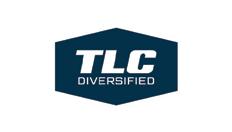





























































Not all heroes wear capes.
of
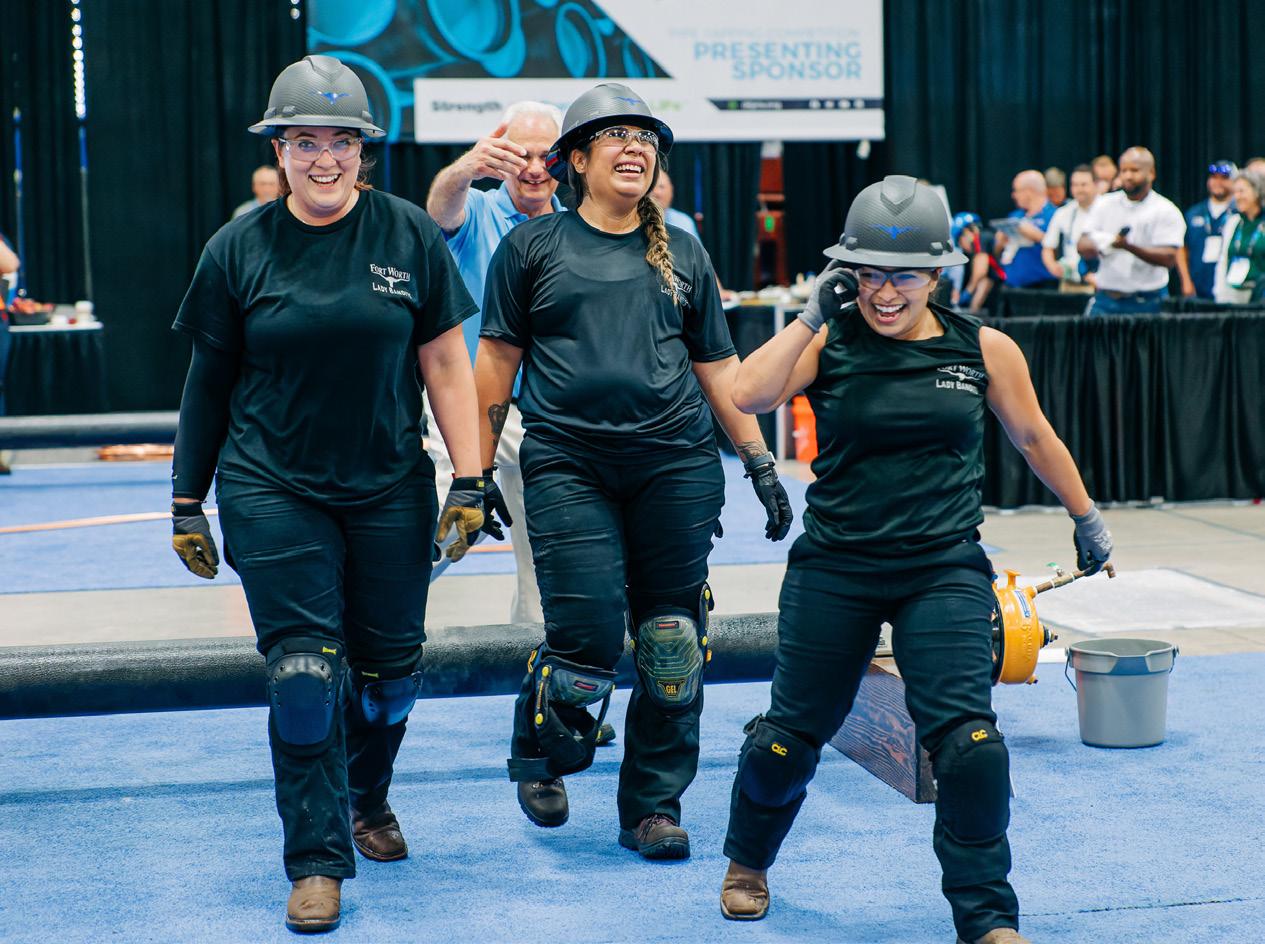
Dedicated to the World’s Most Important Resource®
We appreciate your continued support of AWWA. Enjoy 20% off products in the AWWA store through December 31. Use promo code THANKYOU at checkout.* *Exclusions may apply.
Ours wear hardhats. Here at American Water Works Association, we know the countless hours
hard work and expertise it takes to keep water—the world’s most important resource—safe and clean. We thank our members for their dedication and celebrate all they have accomplished in the water community this year. Thanks to our members, we can build a better world through better water.

Florida Water Resources Journal • December 2022 31
An Innovative Septic Phaseout Program
Josefin Hirst, Damann Anderson, and Michael Dvoroznak
Approximately 65,000 septic systems and 35,000 private water wells remain in the JEA service areas of Duval, St. Johns, and Nassau counties. Over time, the City of Jacksonville (city), with technical support from JEA, has led multiple septic tank phaseout programs in areas without central water and sewer infrastructure. These infrastructure projects were accomplished through city capital project initiatives, with contributions by JEA. The work continues today with the current septic tank phaseout (STPO) program.
In 2003, the Water and Sewer Infrastructure Task Force was formed by the city and JEA. The task force recommended the development of a prioritization system for the phaseout of remaining septic systems. The prioritization system was created by the city’s regulatory and environmental services department in consultation with the Duval County Health Department.
The 2003 prioritization system focused on environmental, public health, and welfare considerations, including the number of septic tank system repair permits issued, average lot size, soil potential, seasonal high water table, sanitary conditions, proximity to any surface water body, and potential for flooding in the areas. In 2016, the city and JEA collaborated to modify the STPO program approach to prioritization and allocation of funding to include certain additional community considerations.
To that end, a STPO project area matrix was jointly developed, which has been updated annually. The matrix included data in two distinct sections. The first section contained environmental, health, and welfare parameters with a maximum of 70 points possible toward an overall total score for prioritization. The second section contained community consideration parameters with a maximum of 30 points possible toward the overall total score.
Table 1.
Description
The most recent 2020 matrix update resulted in the prioritization of approximately 22,000 residential parcels with existing septic systems (out of the total 65,000) into 35 STPO priority project areas. The top tier in the matrix (meaning the most important to implement) included three areas with septic conversion projects already underway at various stages: Biltmore C and Beverly Hills (under construction), and Cristobel (initiation of preliminary design engineering services). Historically the STPO program projects have replaced existing septic systems with conventional gravity collection systems.
An innovative wastewater treatment program (IWTP) was created to assess and recommend the most appropriate technologies and approaches (including centralized sewer, decentralized sewer and treatment, and/ or improved onsite treatment) that could be applied to the remaining 32 prioritized STPO project areas. The planning documents developed as part of this project identified approaches that may also be used in the future for the approximately 43,000 additional septic systems that remain in Duval County.
Identification of Applicable Alternatives for the Septic Phaseout Program
A brainstorming exercise for outsidethe-box ideas and a comprehensive literature and industry best practices review of regional, national, and international research related to innovative technologies, strategies, and frameworks for septic system replacement identified alternatives that were screened for applicability to the septic phaseout program. Peer-reviewed journal articles, conference proceedings, case studies, reports, and technical information from manufacturers in the United States and internationally were synthesized to
Josefin Hirst, P.E., is senior associate with Hazen and Sawyer in Orlando. Damann Anderson, P.E., is vice president with Hazen and Sawyer in Tampa. Michael Dvoroznak, P.E., is manager–water/wastewater reuse treatment maintenance planning and engineering with JEA in Jacksonville.
identify limitations, challenges, and lessons learned.
The literature review identified wastewater treatment technologies for both decentralized and onsite management strategies. Centralized collection system alternatives were assumed to utilize JEA’s existing municipal wastewater treatment facilities.
The assessment included:
S Technologies - Equipment developed for wastewater collection, treatment, and/ or effluent disposal (such as vacuum sewer system, biological treatment, and engineered wetlands).
S Wastewater Management StrategiesStrategies for managing STPO priority-area wastewater in lieu of existing septic systems (such as advanced onsite, decentralized, centralized, integrated, and source separation).
S Institutional Frameworks - Methods used to own, operate, finance, and implement wastewater management strategies (such as public, private, and design/build/operate/ finance).
The identified onsite, decentralized, and centralized alternatives were preliminarily ranked based on the following:
S Ability to meet programmatic goals
S Technology maturity and experience
S Regulatory considerations/uncertainty
S Ease of management
S Sensitivity to flooding
S Reliability of equipment
S Odor
S Aesthetics
S Construction impacts
Total Parcels no. 35 4,802 913 29,214
Septic Parcels no. 34 3,714 735 23,516
Proportion Septic Parcels % 49 100 83
Proportion Residential Parcels % 80 100 95
Eq. Res. Units no. 32 4,239 706 22,582
Average Res. Parcel Acreage acres 0.19 1.82 0.45
Vacant Acreage acres 0 158 29 916
Vacant Government Owned Acreage acres 0 28 4 138
S Impact to property restrictions
S Net present cost
An overarching goal of the study was to identify best-value methods for accomplishing the large-scale septic-to-sewer conversion program.
32 December 2022 • Florida Water Resources Journal
FWRJ
Units Minimum Maximum Average Total
General Overall Characterization of 32 Septic Tank Phaseout Priority Project Areas
Characterization of Project Areas
The 32 STPO priority project areas were grouped according to existing JEA wastewater treatment facility (WWTF) service areas. The STPO priority areas were located within six WWTF service areas:
S Arlington East
S Buckman
S Cedar Bay (District 2)
S Mandarin
S Monterey
S Southwest
Currently, no STPO priority project areas are within the Blacks Ford, Julington Creek Plantation, Ponte Vedra, Ponce de Leon, or Nassau Regional WWTF service areas. The STPO priority area characterization, which was used when assessing alternative wastewater capital improvements, included an analysis of existing customers, septic system density, land use, existing utilities, topography, other existing infrastructure and environmental factors (including sea level rise). Table 1 summarizes certain metrics for the aggregated 32 remaining STPO priority areas considered.
The 32 STPO priority areas were categorized based on similar septic system density (i.e., lot size) characteristics, and nine representative STPO priority areas were chosen for more-detailed planning-level cost analysis for various strategies and technologies.
Development of Recommended Septic Tank Phaseout Priority Area Wastewater Improvements
Recommended wastewater improvements for each STPO priority area were formulated by combining the characterization of each STPO priority area with the top-ranked identified wastewater management strategies, institutional frameworks, and technologies. This analysis resulted in recommended wastewater capital improvements for each STPO. The representative area planning-level cost estimates were used to estimate costs for the remaining priority areas. These costs, along with an additional eight criteria, were used to further evaluate wastewater capital improvement alternatives for each STPO priority area. The detailed evaluation resulted in a top-ranked wastewater capital improvement recommendation for each STPO priority area.
The STPO priority area characterization indicated that parcels with a topographic elevation below 6 ft could be significantly impacted by future sea level rise, with expected groundwater rise limiting the unsaturated
Table 2. Septic Tank Phaseout Priority Areas Program Cost1 Summary (2020 dollars)
Description
Phaseout Cost 32 STPO Priority Areas
Phaseout Cost Per Connection (Average)
Estimated Total Capital Construction Costs $783M $39,000
Estimated 20 year Operation and Maintenance (O&M) Net Present Costs (NPC)2 $75M $4,000
Estimated Total NPC $858M $43,000
1 Preliminary engineer’s opinion of probable construction costs (EOPCC) have been prepared based on master plan level information. Because of the level of scope development at this stage, the estimate is an "order of magnitude" estimate as defined by the Association for the Advancement of Cost Engineering International (AACE) Class 5. The expected range of accuracy for this type of estimate is 50 to 100 percent. These costs have been prepared for guidance in project evaluation and implementation from the information available at the time of the estimate. The final costs of the project will depend on actual labor and material cost, competitive market conditions, final project scope, implementation schedule, and other variable conditions. As a result, the final project costs will vary from the estimate presented herein. The capital construction costs do not include new water services or new stormwater drainage aspects to the project areas.
2 The presented 20 year O&M net present costs (NPC) were determined based on 2.5 percent discount rate, which is the current rate for federal water projects.
thickness of the soil, which would hinder operation and treatment efficacy of some advanced onsite wastewater treatment systems and other technologies; therefore, only the STPO priority areas above this topographic limitation and with an average parcel acreage greater than 0.25 acres included onsite wastewater improvements as a solution alternative in the detailed evaluation.
For STPO priority areas, either located far away from existing JEA infrastructure or within an area of the JEA service area with limited available capacity, a low-cost approach to wastewater treatment could be a new decentralized wastewater treatment facility. A preliminary cost analysis for new infrastructure to the existing wastewater infrastructure point of connection (POC) indicated that only the areas with a POC greater than 4,000 lin ft from the boundary have the potential to offset the additional cost of decentralized treatment.
A total of approximately 23,516 prioritized unsewered parcels in the service area were evaluated for potential wastewater capital improvements. Of the total parcels, 22,913 (97 percent) were recommended to be served by a vacuum collection system, 207 connections were recommended to be served by a gravity collection system, and 223 connections were recommended to be served by a lowpressure collection system. The remaining 173 connections were recommended to be served by an advanced onsite treatment system. Planninglevel cost estimates were prepared for each STPO priority project area for the purpose of defining the total wastewater capital improvement costs for the STPO program. A summary of the estimated capital costs for the STPO priority project areas is shown in Table 2.
The study identified that vacuum sewer collection systems were the best-value method
for project areas with more than 150 existing septic systems. For remote project areas with large lots, the advanced onsite wastewater treatment systems met the project goals, and smaller project areas resulted in a mixture of low-pressure sewer collection systems and conventional gravity sewer as the best-value capital wastewater improvement.
Conclusion
The conclusions and recommendations from the comprehensive one-and-a-half-year study effort included evaluations of multiple technologies, wastewater management strategies, and institutional frameworks. An overarching goal of the study was to identify best-value methods for accomplishing the largescale septic-to-sewer conversion program. The septic tank conversions contemplated were evaluated (using weighted criteria) without consideration of other major construction within the public right of way.
It’s possible that certain conversion project areas may ultimately include investments in water service, stormwater drainage, or other infrastructure which, if considered, could affect the weighted criteria analysis conclusions. For example, if a project area were to include major water and drainage improvements, the entire right of way may require roadway reconstruction. In such an instance, it’s possible that a different sewer approach (e.g., gravity instead of vacuum) may ultimately represent a better value to JEA. Moreover, the technology evaluation presented here could be affected by changes to legislation, available funding, etc. Hence, review of all such factors will be considered during detailed design to validate the approaches identified and to develop final construction plans and estimated costs. S
Florida Water Resources Journal • December 2022 33
Babcock Ranch: A Community With a Focus on Sustainability
 Al Mitrovic
Al Mitrovic
The Florida Water Environment Association (FWEA) proudly recognizes the Babcock Ranch Water Reclamation Facility (WRF) as the winner of the 2022 Earle B. Phelps Award in the advanced secondary treatment category. This award is presented annually to wastewater treatment plants that demonstrate exceptional effluent
quality throughout the year and maintain the highest removal of major pollutioncausing constituents. The WRF is noted for its consistency in providing a high-quality effluent, as well as its dedication to green energy practices and sustainability.
The WRF has been the recipient of multiple awards, including:
S The 2018 First-Place Safety Award Class C
from FWEA for the plant’s excellent safety programs.
S The 2018 Plant Operations Excellence Award from the Florida Department of Environmental Protection (FDEP) for the plant’s excellence in operation, maintenance, innovative treatment, waste reduction, pollution prevention, recycling, and other special achievements.
S The 2018 David B. Lee Award from the Florida Water and Pollution Control Operators Association (FWPCOA) for the leadership and operational effectiveness of Nathaniel Mastroeni, utility operations manager.
S The 2019 David W. York Award for Reuse System of the Year presented by the FWEA Water Resources, Reuse, and Resiliency Committee for the plant’s commitment to developing, using, and maintaining exemplary reuse programs.
S The 2019 Earle B. Phelps Award in the advanced secondary wastewater treatment category awarded by FWEA to recognize the facility for its removal of major pollution-causing constituents prior to effluent discharge to receiving waters.
These awards are a testament to the district for its dedication and commitment in protecting local water resources and the environment.
The Community
The town of Babcock Ranch is located northeast of Fort Myers and has a footprint of approximately 18,000 acres. Under the current master plan, it’s designed to accommodate 19,500 residences and has an engaging downtown with commercial and retail space, numerous green spaces, lakes, and nature trails. Ultimately, it will be home to approximately 50,000 residents.
The WRF and reclaimed system is operated by MSKP Town and Country Utility (TCU) with the objective of providing water utility services to the new Babcock Ranch
Figure 2. Process flow diagram. Continued on page 36

34 December 2022 • Florida Water Resources Journal PROCESS PAGE
Greetings from the FWEA Wastewater Process Committee! This month’s column will highlight the Babcock Ranch Water Reclamation Facility, which won the 2022 Earle B. Phelps Award in the advanced secondary category for facilities with a design capacity of less than 3 mil lion gallons per day.
Figure 1. The Florida Power and Light Babcock Ranch Solar Energy Center.

Florida Water Resources Journal • December 2022 35
community. The WRF was commissioned into service April 2017 and the entire town, including the WRF, operates on solar power. The Florida Power and Light Babcock Ranch Solar Energy Center (Figure 1) opened as the largest solar-plus storage project operating in the United States and has a generating capacity of 150 megawatts (MW), with 10 MW of battery storage.
Babcock Ranch has been designed to incorporate the most sustainable green technology practicable to meet the growing demands of its innovative community. Drinking water is obtained from the sandstone aquifer and is filtered using nanofiltration (NF). The NF concentrate is recycled by blending with the WRF effluent and is stored as reclaimed water. All irrigation throughout the community uses this water to irrigate the town and provide fire protection.
Facility Overview
The WRF is permitted for an annual average daily flow (AADF) capacity of 0.375 million gallons per day (mgd) and can handle peak daily flows up to 1 mgd. All the equipment maintains Class 1 reliability, which includes onsite backup power generation in the event of a power outage. The treatment system is a fourstage Bardenpho process; a flow diagram is shown in Figure 2. Reclaimed water is sent to a nondischarging lake that is directly connected to a G-II aquifer. The lake will serve as storage for a future slow-rate, public access reclaimed water irrigation system.


The TCU utilizes its own computerized maintenance management system using Excel, where every piece of equipment is tracked according to the operation and maintenance manuals. Utility personnel update these spreadsheets on a weekly basis to ensure that all assets are properly maintained.
Process Description
The 0.375-mgd WRF was originally designed with sequencing batch reactors that have since been repurposed for a four-stage Bardenpho nutrient removal process, followed by membrane filtration. For mechanical screening at the headworks, TCU selected 2-millimiter stainless steel drum screens. All mechanical equipment operates in a duty/standby configuration and allows for Class 1 reliability.
Effluent from the swing zone flows into one of the two 17,000-gallon membrane bioreactor (MBR) tanks (Figure 3) with the SUEZ leap-high, leap-low MBR system at

36
Figure 3. Membrane bioreactor tank.
Figure 4. Membrane bioreactor permeate pumps.
34
Figure 5. Chlorine tanks.
Continued from page
Figure 6. Aeration blowers.
the heart of the facility. The system utilizes ZeeWeed ultrafiltration membranes, which provide a barrier that prevents the passage of solids and produces a low-turbidity effluent, allowing the water to be returned to the environment or reused for irrigation and fire suppression.




Filtrate from the MBR is pumped by the permeate pumps (Figure 4) into the back pulsation tank, which provides the flow required for carrying out periodic maintenance and recovery cleaning of the membranes. The flow is then diverted into the chlorine contact tanks (Figure 5), with a total capacity of 52,000 gallons. Two peristaltic pumps are used for disinfection. The chlorine contact tanks are designed to provide highlevel disinfection, with a contact time of 25 minutes at peak-hour flows of 3 mgd. Disinfection is provided by a 12.5 percent sodium hypochlorite solution with a 30-day storage capacity.
The disinfected effluent discharges by gravity over a weir and combines in a pump station wet well. Effluent meeting the criteria
Annual Average Influent
Table 1. Plant Loadings and Effluent Quality
cBOD (mg/L) TSS (mg/L) Fecal (CFU) Turbidity (NTU) TN (mg/L)
353.9 251.9 N/A N/A 56.4
Annual Average Effluent 2.3 0.6 1 0.3 2.19
% Removal 99.3% 99.4% 95.4%
Number of Occurrences
Out of Compliance 0 0 0 0 0
for use as public access reclaimed water is blended with NF concentrate from the water treatment plant (WTP) and is transferred by gravity to a 160-acre lake. This water is also used for irrigation and fire suppression. Any reject effluent is diverted to a million-gallon reject substandard tank, where it’s pumped to the head of the plant for additional treatment.
Additionally, the facility has an aerated biosolids holding tank, with two sludge drying beds for disposal of waste sludge.
Instrumentation and Monitoring
The instrumentation and plant monitoring system consists of dissolved oxygen (DO) probes placed at each of the aeration basins and swing zones. The DO levels are achieved with variable frequency drive blowers (Figure 6) that shut off once the desired oxygen concentration is reached. Probes measuring total suspended solids (TSS) are placed at the common return activated sludge (RAS) splitter box/membrane
page 38
Figure 9. Town and County Utilities team photo.
Figure 8. From left are Jason Bailey, Taran Brown, and Myles Adrian.
Figure 7. From left are Myles Adrian, Taran Brown, and Jason Bailey, members of the plant operation staff. Continued on
tank inlet piping, allowing for TSS monitoring of what is entering and leaving the membrane tank.
Continuous trending and monitoring of the transmembrane pressures on the ultrafiltration process provide the staff with an indication of system performance. The staff also regularly samples and monitors mixed liquor suspended solids (MLSS), mixed liquor volatile suspended solids (MLVSS) concentrations, time to filter testing (indicating permeability conditions of the solids), and nitrate and ammonia. Monitoring these parameters allows for excellent control of the treatment process, yielding an annual average effluent total nitrogen of 2.19 mg/L.
Table 1 summarizes the typical plant loadings and effluent quality.
Sustainability Goals
Babcock Ranch is entirely solar-powered and has an overall objective to build one of the most sustainable communities in the U.S. This ambitious goal is reflected in the city’s master planning, which incorporates green technology wherever possible.
Aside from genuine care for the operation of the facility, the TCU staff members have an overall vision for the sustainability of the wastewater infrastructure of Babcock Ranch as a whole, which is inspiring to see. Describing themselves as a “symbiotic community,” they ensure that every drop of both reclaimed water and concentrate from the WTP has been reused since day one.
Plant Staff
The TCU, which runs the WRF, has a deep commitment to providing employees with a safe and healthful workplace (Figures 7, 8, and 9). This includes providing them with personal protective equipment and regular safety classes. All equipment at the facility is labeled to be easily identifiable.
Using quality assurance/quality control (QA/QC) training, each team member is given the task of researching and composing operation and maintenance standards of practice that are reviewed with the management team. This creates a sense of ownership when it comes to learning.
The utility also shows a strong dedication to the onboarding of new employees. New hires
go through a training phase, where the utility management team assigns each one to shadow an experienced plant operator. Training typically lasts for 18 months, and the trainees have an opportunity to learn routine tasks from senior operators and field crew.

Conclusion
The WRF is powered by the sun and consistently succeeds in providing highquality effluent that meets advanced secondary criteria. The facility is noted for its dedication to green energy practices and its contributions to one of the most sustainable communities in the U.S. The beneficial use of reclaimed water has reduced the domestic residential daily water usage at Babcock Ranch from a state average of 85 gallons per capita (based on the 2010 report, “Estimated Public Supply Water Use and per Capita Use in Florida by County”).
The FWEA Wastewater Process Committee is proud to highlight the accomplishments of this facility!




Al Mitrovic, P.E., is a professional engineer with Wade Trim in Tampa. S

38 December 2022 • Florida Water Resources Journal
Continued from page 37
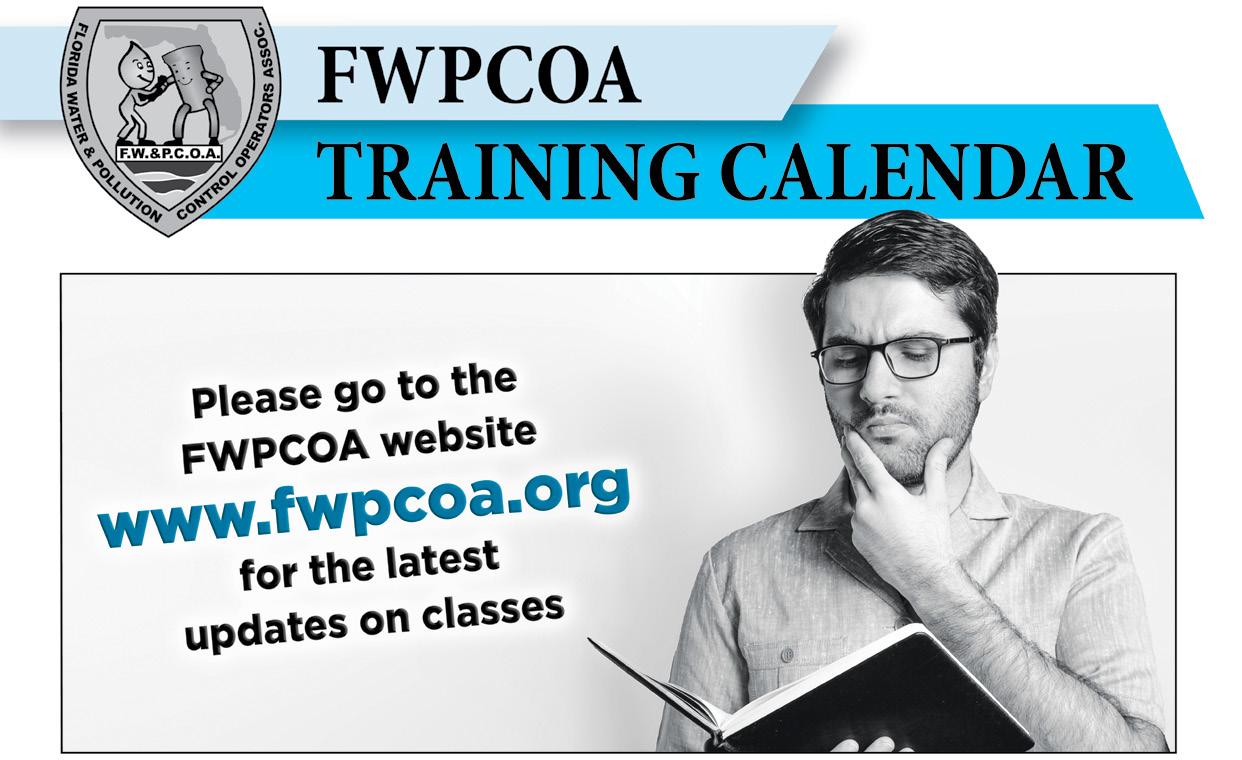

December 5-7............ Backflow Repair............................................................... Deltona .............. $275/305 7............ Backflow Tester Recertification and Exams ........... Deltona .............. $85/115 13-16............ Water Distribution 2 ....................................................... Deltona .............. $325/325 February 6-10 Wastewater Collection C Orlando $325.00 March 13-17............ 2023 SPRING SHORT SCHOOL Florida Water Resources Journal • December 2022 39
What Do You Know About Wetlands?
6. Per FDEP’s Domestic Wetlands as Reuse website, other wetlands projects may also be considered reuse if it’s properly demonstrated that the application of reclaimed water will effectively “enhance” and continue to “enhance” the wetland. How is “enhancement” determined?
10. Per FDEP’s Environmental Resource Permit (ERP) Dredging and Filling website, who regulates any activity on or over wetlands?
a. FDEP
b. FDEP and the five water management districts
1. Per Florida Administrative Code (FAC) 62-611, Wetlands Application, “treatment wetland” means a wetland within the landward extent of waters of the state used to treat reclaimed water that has received
a. secondary treatment.
b. secondary treatment with filtration.
c. secondary treatment with nitrification. d. tertiary treatment.
2. Per FAC 62-611, what is the maximum concentration of phosphorus, on an annual average, allowed to be discharged to a receiving wetland?
a. 1 mg/L b. 2 mg/L c. 3 mg/L d. 5 mg/L
3. Per FAC 62-611, unless an applicant can demonstrate that a shorter detention time will provide the required level of water quality, the minimum detention time of reclaimed water within a treatment wetland shall be no less than
a. five days. b. seven days. c. 11 days. d. 14 days.
4. Per FAC 62-611, what is the limit of total ammonia (as N) that can be discharged to a treatment or receiving wetland?
a. 1 mg/L b. 2 mg/L c. 5 mg/L d. 10 mg/L
5. Per the Florida Department of Environmental Protection (FDEP) Domestic Wastewater Wetlands as Reuse website, manmade wetlands, as well as hydrologically altered wetlands used for wastewater treatment, can be considered reuse if
a. proper documentation of created or restored habitat is submitted.
b. reuse is also provided for public access irrigation.
c. the wetlands project is permitted under FAC 62-610, Reuse of Reclaimed Water and Land Application.
d. the project is also considered a groundwater recharge project.
a. The project meets the requirements set forth in FAC 62-611.
b. The project meets the requirements set forth in FAC 62-610.
c. Wastewater treatment plant effluent meets the water quality-based effluent limits of FAC 62-650.
d. Enhancement is not defined by the rules and is determined on a case-by-case basis.
7. Per FAC 62-610, Reuse of Reclaimed Water and Land Application, how often must a wetlands creation, restoration, or enhancement project documentation be reviewed by FDEP to ensure that the wetlands creation, restoration, and enhancement attributes of the project remain applicable?
a. Every six months b. Annually c. Biannually d. With each permit renewal
8. Per FAC 62-611, FDEP must be provided with reasonable assurance that public access to a treatment or receiving wetland shall be restricted unless
a. the wetland is manmade. b. high-level disinfection is required. c. the wetland is contiguous with other waters.
d. flora and fauna are protected with fencing.
9. Per FDEP’s Wetland Evaluation and Delineation website, what part of FAC 62340, Delineation of the Landward Extent of Wetlands and Surface Waters, is used in the identification and delineation of wetlands within Florida?
a. Florida Wetlands Description
b. Vegetative Index
c. Wetlands Flora and Fauna List
d. Wetlands and Surface Water Delineation Criteria
c. U.S. Environmental Protection Agency (EPA) and FDEP
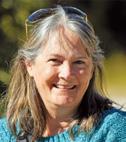
d. Local regulatory agencies and FDEP
Answers on page 50
References used for this quiz:
• Florida Administrative Code 62-611, Wetlands Application: https://www.flrules.org/gateway/ChapterHome. asp?Chapter=62-611
• Florida Administrative Code 62-610, Reuse of Reclaimed Water and Land Application: https://www.flrules.org/gateway/ChapterHome. asp?Chapter=62-610
• Florida Administrative Code 62-340, Delineation of the Landward Extent of Wetlands and Surface Waters: https://www.flrules.org/gateway/ChapterHome. asp?Chapter=62-340
• Florida Department of Environmental Protection - Domestic Wastewater Wetlands as Reuse website: https://floridadep.gov/water/domesticwastewater/content/domestic-wastewaterwetlands-reuse
• Florida Department of Environmental ProtectionWetland Evaluation and Delineation website: https://floridadep.gov/water/submerged-landsenvironmental-resources-coordination/content/ wetland-evaluation-and
• Florida Department of Environmental ProtectionEnvironmental Resource Permit (ERP) Dredging and Filling website: https://floridadep.gov/water/submerged-landsenvironmental-resources-coordination/content/ erp-dredging-and-filling
Send Us Your Questions
Readers are welcome to submit questions or exercises on water or wastewater treatment plant operations for publication in Test Yourself. Send your question (with the answer) or your exercise (with the solution) by email to: donna@h2owriting.com
40 December 2022 • Florida Water Resources Journal
Test Yourself
Donna Kaluzniak
Welcome to the FWEA Chapter Corner! The Member Relations Committee of the Florida Water EnvironmentvAssociation hosts this article to celebrate the success of recent association chapter activities and inform members of upcoming events. To have information included for your chapter, send details to Melody Gonzalez at gonzalezm@bv.com. Melody Gonzalez
Get Involved With the FWEA Students and Young Professionals Committee!

 Nicole Cohen, P.E., ENV SP
Nicole Cohen, P.E., ENV SP
The mission of the Students and Young Professionals Committee (SYPC) is to develop and implement programs to increase the activity and membership of students and young professionals in the Florida Water Environment Association (FWEA). Involvement and participation within the committee is vital since these individuals are the current and future leaders of our industry.
Internship Program
The SYPC is excited to announce the firstever FWEA internship program. The purpose of this program is to help inform and guide talented individuals to reputable companies, utilities, and organizations within the Florida
program or getting involved, please reach out to fwea.sypc@gmail.com.
Events at the Florida Water Resources Conference
The Florida Water Resources Conference (FWRC) will be held at the Gaylord Palms in Kissimmee from May 31 to June 3, 2023. Each year at FWRC, the SYPC organizes and holds the annual statewide Student Design Competition. This competition tasks student members within FWEA to design and present a solution to a problem statement that they have worked on together as a team.

At this year’s FWRC, Florida Gulf Coast University (FGCU) and University of South Florida (USF) were the first-place winners in their categories and represented FWEA and their respective universities at the 2022 Water
In addition to organizing the competition, the SYPC hosts many other events at FWRC, such as the poster competition, which provides students and young professionals the opportunity to present at FWRC. Prizes are awarded to the top two posters. Additionally, the SYPC organizes and hosts the Young Professionals (YP) Symposium and the Students and Young Professionals Social at the conference. Stay tuned for further details
The SYPC administers the FWEA Young
2022 Student Design Competition teams.
Florida Water Resources Journal • December 2022 41 FWEA CHAPTER CORNER
Continued
42
FWRC
on page
Professional of the Year Award, recognizing outstanding service to FWEA. This award goes to an outstanding young professional who shows leadership, initiative, and technical knowledge, and actively participates within FWEA. The winner also earns a paid trip to attend the annual AWWA/WEF YP Summit. Nominations are open and available on the SYPC webpage. Forms must be received by March 24, 2023.
On top of all those activities, the SYPC

also works hard to organize, coordinate, and conduct outreach events at universities and at FWEA’s respective student chapters. We’d like to give a big thanks to our members and

If you’re interested in participating in or sponsoring the SYPC, please send an email to fwea.sypc@gmail.com or any of the committee’s leadership: S Chair - Nicole Cohen: NCohen@carollo.com



S Vice-Chair - Kamal Taha: Kamal.Taha@arcadis.com




S Treasurer - Olga Mikhalchishina: OMikhalchishina@woodardcurran.com


S Secretary - Jissell Muir: Jissell.Muir@arcadis.com
Nicole Cohen, P.E., ENV SP, is a project engineer with Carollo Engineers in Sarasota. She serves as FWEA’s Students and Young Professionals Committee chair and is a member of the FWEA Manasota Chapter. S
42 December 2022 • Florida Water Resources Journal
FWRC 2022 Young Professionals Symposium panelists.
Continued
page 41 Factory Trained Technicians - Emergency Repair Services - PM Service/Plans Gas Feed Systems Dry Chemical Feed Systems Peristaltic Pumps Fiberglass Enclosures Metering Pump Skids Tablet Feeders Analyzers Scale Systems Serving the Southeast since 1976 800–826-7699 watertc@watertc.com watertc.com
FWRC 2022 Poster Competition.
from
WR3 Seminar in 2022 Shines
Brightly in City of Plant City!
Kevin Carter
On February 3 of this year the Water Resources, Reuse, and Resiliency Committee (WR3) hosted its annual seminar in the great City of Plant City’s new Sadye Gibbs Martin Community Center. Over 50 water-sector professionals gathered to share and learn from each other, as well as make connections at the first WR3 in-person event in over two years. As WR3 chair at the time, I had the honor to facilitate the event and it was great to see everyone in person again!


The day started with a nice surprise visit from Bill McDaniel, city manager, and Jack Holland, assistant city manager, with the City of Plant City. It was a privilege to have the city’s leadership greet and welcome us. Both gentlemen have served the city for their entire, impressive careers and their opening remarks certainly set a great tone for the day.
After finishing up some tasty morning snacks and filling our coffee cups, we sat down and began our comprehensive agenda for the event, which was titled, “One Water: Setting the Stage for a Sustainable Future.” With our committee’s name containing water resources, reuse, and resiliency, our seminars traditionally cover many interesting and diverse topics and we kept to that tradition well into 2022.
A Packed Agenda
We started our program with Walt Woodard from InfoSense describing how his company’s technology can optimize sewer cleaning and reduce water consumption. A trio of excellent speakers—Pranjali Kumar and Mary Fickert with Carollo Engineers, and Nory Hancock from Pinellas County—shared their regional partnership success stories on water supply diversification. This panel also gave us a look into the “crystal ball of tomorrow,” when innovative water reuse (e.g., potable reuse) will be critical for future water supply planning.
We took a networking break, which is always one of the best reasons to attend a WR3 seminar. It’s enjoyable to start new conversations, as well as continue long-running ones, with our friends and colleagues from around the state.
Michael Cole with Nexom kicked off the second session by explaining how wastewater plants can intensify treatment and add nitrification capacity without adding to their footprint. A focus on technology continued with a presentation by Joe Tardio with Aqua-Aerobic on how to reduce life cycle costs for water reuse
treatments utilizing aerobic granular sludge and cloth media filtration.
Our “hosts with the most,” Lynn Spivey and Pat (Murf) Murphy from the City of Plant City, then brought in for lunch some of the tastiest barbeque many of us had experienced. I will be back to visit the city just to find this deliciousness again on my plate, but would also stop to say hello to Lynn and Murf.
Well-nourished, we continued the dialogue into the afternoon with a focus on potable reuse.
from JEA then shared JEA’s next step in potable reuse—its H2O purification facility—that builds off of its successful pilot program.
We shifted gears for the presentation, “Florida Resilient Grant Program and Regulatory and Legislative Updates,” by Laura Donaldson, from Manson Bolves Donaldson Varn, and myself. Many bills were covered and we’ll certainly be ready for more resiliency funding in 2022 and beyond.
We closed out our day with a virtual visit from two colleagues from Minnesota, Chris Larson with HDR and Ali Elhassan from Met Council Twin Cities, who discussed their present
Florida Water Resources Journal • December 2022 43
Seminar attendees.
Continued on page 44
The One Water Florida booth from the Southwest Florida Water Management District.
and future water sustainability planning. While they would have liked to be present in person (as it was basically 0 degrees Fahrenheit where they were!), they continued another great WR3 tradition to learn from others around the country and the world.
Thanks to the Sponsors, Volunteers, and Attendees
As you may be aware, successful events like this don’t happen overnight. Ryan Messer with HDR, our WR3 vice chair and seminar chair, led our planning for the third straight year and helped to ensure our success. Thank you, Ryan, for your vision, leadership, and coordination to make a great day happen.
Thanks also go to Nita Naik from Wade Trim, our past chair, for her great work with seminar planning and logistics. Samantha Nehme, with Kimley-Horn and the WR3 secretary, also assisted with event coordination and onsite registration.
Thanks to Mike Knowles, with Peace River Manasota Regional Water Supply Authority and our treasurer, for also participating in the event planning, along with our WR3 communications lead, Elizabeth Thomas.
We also recognize Tonya Sonier who chairs the FWEA Seminars Committee, especially as we worked to plan and secure the continuing education certifications. We also thank the Florida Water Environment Association (FWEA) board of directors and Ronald Cavalieri, who’s
with AECOM and the FWEA past president, for their leadership as they “set the table” for our committee’s successes throughout the year.
Some newer members helped us this year, including Diego Labarca with Black & Veatch, who assisted Ryan well with the call for abstracts process and also helped with other event planning, along with one of our newest members, Hai Vu from JEA.




Some veteran members, including Arturo Burbano at Black & Veatch, Kristiana Dragash with Carollo, Terri Lowery from Jones and Edmunds, and Lisa Wilson-Davis with City of Boca Raton, provided valuable input during the conference planning meetings.

I also want to thank Anthony Andrade from the Southwest Florida Water Management District (SWFWMD) for coordinating with SWFWMD’s Robyn Felix to bring the One Water Florida display booth and water bottles to our event.



The WR3 is also very appreciative and thankful for Karen Wallace, FWEA’s executive manager, who guides and assists us through the whole process while doing the same for the rest of the FWEA family. Thank you, Karen!
Major thanks go to all the participants who attended the event and asked interesting questions and contributed greatly to the day’s overall dialogue. Thanks also go to our many sponsors! We can’t hold these events without your support, and it’s truly appreciated.
Last, but definitely not least, many thanks again to Lynn, Murf, and the City of Plant City for hosting our great day. All the eventday logistics went well thanks to them and the excellent city parks staff. Lynn and Murf were also key contributors in the event planning and agenda development. And did I mention the great barbeque?



Lynn also does a great job as a past WR3 chair and current FWEA director at large. Thank you both for inviting us to your beautiful hometown for our annual seminar.
Future Events
We’re planning to host a 2023 in-person seminar along the southeast Florida coast, so please stay tuned to future Droplet editions and an upcoming revamped website for future event news.
I also encourage you to attend our monthly meetings, typically held the first Tuesday of the month, unless other events occur. Please email me at kcarter@broward.org if you want information on the meetings or anything else about WR3.
Kevin Carter is assistant to the director at the Broward County Water & Wastewater Services and immediate past chair of the Water Resources, Reuse, and Resiliency Committee. S
44 December 2022 • Florida Water Resources Journal
Thank you to our Sponsors 2022 WR3 One Water Seminar Attendees listen to one of the many presentations. The sponsors were acknowledged at the seminar. Continued from page 43

WWEMA Elects 2023 Officers and Directors
The members of the Water and Wastewater Equipment Manufacturers Association (WWEMA) elected new officers and directors during its 114th annual meeting held Nov. 2-4, 2022, in San Diego.
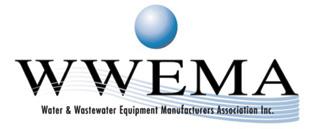
The 2023 WWEMA Executive Committee members are:
S Chair William (Bill) Decker - vice president and general manager–equipment services group, Aqua-Aerobic Systems Inc., Loves Park, Ill.
S Chair-Elect Henk-Jan van Ettekoven - president, HUBER Technology Inc., Denver, N.C.
S Vice Chair Jay Conroy - president, HydroDyne Engineering Inc., Clearwater, Fla.
S Treasurer Tom McCurdy - director of sales–environmental, Aerzen USA, Coatesville, Pa.
S Immediate Past Chair Vince Baldasare - sales manager, The Gorman-Rupp Co., Mansfield, Ohio
Three members were newly elected to the WWEMA 2023 board of directors:
S Adam Bates - director–water market area, KSB Inc., Henrico, Va.
S Stacy Belanger - product manager–municipal, JWC Environmental, Santa Ana, Calif.
S Richard Ercolini - southeast regional manager, TESCO Controls Inc., Sacramento, Calif.
An additional three members were re-elected to serve a second three-year term:
S Fritz Egger - general manager, SPIRAC (USA) Inc., Newnan, Ga.
NEWS BEAT
S William Flores - vice president–municipal systems and customer service, Smith & Loveless Inc., Lenexa, Kan.
S Michelle McNish - president, Walker Process Equipment, Aurora, Ill.
Since 1908, WWEMA has informed, educated, and provided leadership on the issues that shape the future of the water and wastewater industry. Its member companies supply the most sophisticated leading-edge products and technologies, offering solutions to every water-related environmental problem and need facing today’s society. For more information about the association, visit www.wwema.org or follow WWEMA on LinkedIn at www.linkedin.com/company/wwema/?viewAs Member=true. S
Hurricane Ian, which made landfall in Florida as a Category 4 storm, left scars not only on the land, but also in the water. The storm’s winds and excessive rain washed leaves, organic matter, and contaminants into streams and bays, signaling the beginning of serious environmental effects that could emerge. Researchers say the degraded water quality could damage aquatic ecosystems for weeks, months, or longer and pose a danger to human health in the short term.
Since Ian’s landfall, authorities have received dozens of emails about overflows from wastewater treatment plants along the western coast of Florida, from Palmetto to Fort Myers. Orlando officials have asked residents to limit how often they flush toilets, take showers, wash dishes, and do laundry because of overflowing sewers.
Satellites show an increase in runoff of some of these materials, soils, and overflowing rivers on land into the ocean before Ian hit. Major discoloration in near-shore waters indicates a change in the clarity, or turbidity, of the water.
The brown water seen in the images contains a substance called tannins, which is dissolved organic matter that floats near the top of the water, making it look like tea or coffee. Some of the water’s turquoise color is probably from organic matter and sediment churned to the surface by the hurricane.
The emptying of freshwater streams into the ocean is a natural process and isn’t necessarily a
harmful occurrence at a small scale. The organic materials can in fact serve as food for microbial populations, which are consumed by other animals higher up the food chain, but hurricanes can put such systems into overdrive. Too much floating organic matter can block sunlight from reaching plants deeper in the ocean, decreasing their ability to make food through photosynthesis, eventually leading to the death of plant life. Microbes breaking down the organic matter also increase activity, consuming great quantities of oxygen that would otherwise be available for others, and such oxygendeprived waters make it difficult for plants and fish to survive.
Researchers are particularly concerned for the region’s sea grasses, which require a lot of light and help maintain the local ecosystem. They help prevent erosion, maintain water clarity by trapping sediments and particles with their leaves, and provide food for animals and economically important fish. Poor water quality could wipe out parts of the local sea grass population.
The longer it takes for the water to settle out will define the impact it has on near-shore sea grass habitats. The storm may have also washed in pesticides and herbicides from farms and yards, as well as wastewater products into bodies of water, posing a risk to people’s health if they are exposed.
Such human-induced pollutants and nutrients coming off the land can also spur harmful algal blooms that are dangerous for animals and people.
Harmful algal blooms, also known as red tides, are especially prevalent off the western coast of Florida and can affect fisheries key to the state’s economy.
Researchers are unsure how long water quality issues will last. Flooding has continued across parts of central Florida, raising river levels, causing more destruction and complicating cleanup efforts. Property loss is already estimated at more than $60 billion in Florida, according to an industry trade group.
The effects Ian had on water quality are some of the worst in the state’s recent history, topping 2004’s Hurricane Charley, the last Category 4 storm to make landfall along the western coastline of Florida. After Charley, in almost the same location as Ian, it took weeks for improvements in affected areas like the Charlotte Harbor, just north of Fort Myers. The nearby Peace River was in poor condition for two or three months. R
A contract has been award by Polk County to Electro Scan Inc. to conduct an inspection survey of the county’s 20-inch-diameter wastewater force main. The force main is critical to the county’s wastewater collection system representing its main artery line.
The wastewater flows by gravity to low points in the collection system. From there, it’s collected in lift stations where it’s conveyed through the force main to the treatment facility.
46 December 2022 • Florida Water Resources Journal
A recent single-point failure of the force main prompted the county to investigate the integrity of this critical piece of infrastructure, including determining how much concrete has been lost inside of the pipe, exposing the ductile iron host pipe to corrosive gases from wastewater effluent inside the pipe.
The contract includes an assessment of the existing coating and corrosion levels in the force main and surveys about 3,300 linear feet of pipe. It also includes turnkey project services, including the installation of hot taps, nonacoustic surveying, reporting, and project management. Rangeline Group is also being hired to install selected hot taps and complete any excavations, if needed.
Force mains are often equipped with insertion and retrieval stations to facilitate entry and exits of cleaning equipment. In most cases, insertion facilities are located within the lift station with a removal station located at the discharge point, with longer force mains having multiple insertion points.
Ductile iron, high-density polyethylene, and polyvinyl chloride (PVC) are the most frequently used materials for sewer force mains.
Force main condition assessment is complicated by the fact that they do not have redundant systems or bypasses, and therefore cannot easily be taken out of service for internal inspection. A closed-circuit television (CCTV) inspection is difficult if not impossible because heavy effluent makes camera images opaque.
Since force mains are rarely taken offline, dye testing, ground penetrating radar, lasers, and sonar are not advised.
Acoustic free-flowing sensors or balls have also been used, but lost balls, the potential risk of obstruction or getting loose balls stuck in pipes or pumps, false-positive readings from balls repeatedly hitting the pipe wall, and poor data repeatability offer limited function.
The success in assessing gravity sewer mains for infiltration and corrosion, combined with their expansion into pressurized pipes across multiple pipe materials, will allow key advantages to assess the condition of the wastewater force mains.
R
The Environmental Integrity Project (EIP) has released a national report, “The Clean Water Act at 50: Promises Half Kept at the Half-Century Mark,” which examines water pollution data in all 50 states on the 50th anniversary of the federal Clean Water Act.
The report concludes that 50 percent of 1.4 million river and stream miles nationally, which have been studied in recent years, are so polluted they are classified as “impaired” (despite the Clean Water Act’s promise of making all waterways “fishable and swimmable” by 1983), using the most-recent state water quality reports from the U.S. Environmental Protection Agency (EPA).
The report highlights Florida as ranking first in the United States for total acres of lakes classified as impaired for swimming and aquatic life (873,340 acres), and second for total lake acres listed as impaired for any use (935,808 acres).
The report includes detailed maps and charts, with the most recent available water pollution impairment data for the U.S. For copies of the report and accompanying spreadsheet, contact Ari Phillips, senior writer and editor at EIP, at aphillips@environmentalintegrity.org.
Kennedy Jenks has announced that Matthew (Matt) Munz recently joined the company as a senior project manager, based out of Tampa, serving water and wastewater utility clients across the state. Munz has previously managed multimillion-dollar water, wastewater, reclaimed water, and reuse projects. Using both conventional and design-build delivery methods, he has led projects through all stages, including feasibility studies, planning, permitting, design, construction, and commissioning.
He is experienced in a variety of water, wastewater, reclaimed water, and reuse projects, including feasibility studies, master planning, permitting, design, construction, and commissioning utilizing both conventional and alternative delivery methods. Munz has managed projects ranging in value from less than $10,000 to over $2 million and has substantial experience providing construction engineering and inspection services for utilities projects ranging from treatment plant upgrades to underground utility relocations.
He has a bachelor of science degree in civil engineering from the University of South Florida.
The City of Delray Beach was awarded the 2021 Sustainable Practices Recognition Award from the American Concrete Pavement Association (ACPA) in recognition of its use of pervious pavements in the Osceola Park Neighborhood Project. The award is presented to the organization that demonstrates leadership by implementing sustainable and resilient design and construction practices that consider societal, environmental, and economic factors.
The award was formally presented to Mayor Shelly Petrolia by Amy Wedel, director of concrete pavements of the Florida Chapter of ACPA.
Terrence Moore, city manager, said, “We recognized the need for vision and long-term consideration, while addressing the needs of our community. By employing the latest technological innovations and proven best practices, we will
reduce stormwater runoff and flooding for decades to come.”
Pervious pavement provides multiple benefits to the city and its residents by reducing localized flooding events, protecting water quality, and recharging the local aquifer. The use of pervious concrete allows for the intake of water into the concrete, which acts as a retention area that helps reduce runoff. As the water enters through the open cells of the pavement, aerobic bacteria help to break down harmful pollutants and chemicals.
RThe Osceola Park Neighborhood Improvement project provides multiple benefits to the community, including the permeable pavement for alleys, bioswales in parkways, and other ways to treat stormwater runoff. To learn more about the project, visit OsceolaParkProject.com. R
The American Public Works Association (APWA) has selected a new presidentelect, long-time active member Keith Pugh, P.E., PWLF. Previous presidentelect, Dan Hartman, stepped down from his role, citing ongoing health issues and his concern that he would not be able to give the role the energy it deserves.
Pugh has been active with APWA for over 20 years, starting with serving on the Engineering and Technology Committee. He’s served on other national committees within APWA and been very active in leadership in the North Carolina Chapter.
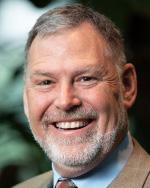
He is a client success manager with WithersRavenel in Asheville, N.C., and assumed the office of president at the Public Works Expo (PWX), which was held August 28-31 in Charlotte, N.C.

R“The APWA has an excellent process with which to fill vacancies in unfortunate situations. The selection of Keith Pugh as president-elect means APWA will continue to be in good hands,” said Stan Brown, APWA president. “His breadth and depth of experience will serve the association well.”
“I am excited to have been chosen to fill the unexpired term of president-elect,” said Pugh. “It’s a challenging role and I look forward to diving into it and helping to guide AWPA through the next year of my presidency.”
The APWA is a not-for-profit, international organization of more than 30,000 members involved in the field of public works. It serves its members by promoting professional excellence and public awareness through education, advocacy, and the exchange of knowledge. Headquartered in Kansas City, Mo., it has an office in Washington, D.C., and 63 chapters and 97 branches throughout North America. S
Florida Water Resources Journal • December 2022 47
Matthew Munz
Keith Pugh
C L A S S I F I E D S
POSITIONS AVAILABLE
Water Plant Operator
Technical work in the operation of a water treatment plant and auxiliary facilities on an assigned shift. Performs quality control lab tests and other analyses, monthly regulatory reports, and minor adjustments and repairs to plant equipment. Applicant must have State of Florida D.E.P. Class “A”, “B”, or “C ” Drinking Water License at time of application. Excellent benefits package. To apply and/or obtain more details contact City of Temple Terrace, Chief Plant Operator at (813) 506-6593 or Human Resources at (813) 5066430 or visit www.templeterrace.com. EOE/DFWP.
SALARY RANGES:
$17.59 - $30.12 per hour • w/”C” Certificate
$19.35 - $33.13 per hour • w/”B” Certificate (+10% above “C”) $21.28 - $36.44 per hour • w/”A” Certificate (+10% above “B”)
The Coral Springs Improvement District
A GREAT place to further your career and enhance your life!
CSID offers…
Salary levels are at the top of the industry Health Insurance that is unmatched when compared to like sized Districts Promotions from within for qualified employees Continuing education courses to develop your skills and further your growth Retirement plans where an employee can earn 18% of their salary by contributing only 6% toward their future
The Coral Springs Improvement District is seeking qualified employees in the following fields: Water Plant Operator
Applicants must have a valid Class C or higher Drinking water license and experience in Reverse Osmosis/Nano Filtration treatment processes preferred however not required. Position requirements include knowledge of methods, tools and materials used in the controlling, servicing, and minor repairs of all related R.O. water treatment facilities machinery and equipment.
Minimum starting salary - $49,088 ($23.60). Salary to commensurate relative to level of license and experience in this field. Trainees who have passed the state exam and only need actual hours worked to obtain the license may be considered.
Benefits:
Wastewater Treatment Plant Operator
Salary Range: $52,645.98 - $91,161.94 (Based on license level and experience)
The Florida Keys Aqueduct Authority’s WASTEWATER DIVISION IS GROWING, and we need two (2) WWTP Operators with a Florida “C” license or higher. You will perform skilled/technical work involving the operation and maintenance of a wastewater treatment plant. This requires technical knowledge and independent judgment to make treatment process adjustments and perform minor maintenance on plant equipment and machinery, in accordance with established standards and procedures. Benefit package is extremely competitive!
Location: Cross Key and Duck Key, FL. Must complete on-line application at www.fkaa.com EEO, VPE, ADA , DFWP
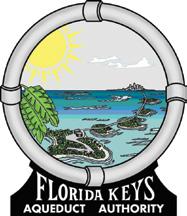
Excellent benefits which include health, life, disability, dental, vison and a retirement plan which includes a 6% non-contributory defined benefit and matching 457b plan with a 100% match up to 6%. EOE. All positions require a valid Florida Drivers license, high school diploma or GED equivalent, be COVID-19 vaccinated, a satisfactory background check, and must pass a pre-employment drug screen test. Please send resume to jzilmer@csidfl.org or fax resume to 954-7536328, attention Jan Zilmer, Director of Human Resources.

City of Titusville - Multiple Positions Available
Water Reclamation Superintendent, Plant Operator Trainee, Utility Asset Program Manager, Maintenance Mechanic, Laboratory Analyst Microbiology, Distribution Foreman, Distribution Operator, Collection Foreman, Collection Operator, Lift Station Electrician. Apply at www.titusville.com
Water Distribution Manager
$76,650 - $118,639/yr.
Reuse Outreach-Water Conservation Manager
$54,473 - $84,315/yr.
Utilities System Operators II & III $44,362 - $62,424 or $48,910 - $68,821/yr.
Apply Online At: http://pompanobeachfl.gov Open until filled.

48 December 2022 • Florida Water Resources Journal
CLASSIFIED ADVERTISING RATES
Classified ads are $20 per line for a 60 character line (including spaces and punctuation), $60 minimum. The price includes publication in both the magazine and our Web site. Short positions wanted ads are run one time for no charge and are subject to editing. ads@fwrj.com
Water Treatment Plant Operators
The Water Treatment Plant at Village of Wellington is currently accepting applications for a full-time Water Operator. Apply online. Job postings and application are available on our website: https://wellingtonfl.munisselfservice. com/employees/EmploymentOpportunities/JobDetail. aspx?req=20&sreq=5&form=WTO3&desc=OPERATOR III, WATER

TREATMENT PLANT
We are located in Palm Beach County, Florida. The Village of Wellington offers great benefits. For further information, call Human Resources at (561) 753-2585.

SOUTH MARTIN REGIONAL UTILITY –ASSISTANT UTILITY DIRECTOR Position Open Until Filled
South Martin Regional Utility is a public municipal utility administered by the Town of Jupiter Island. SMRU has a service area of approximately 22,000 residents, and approximately 9,000 customers. The individual assigned to this position coordinates activities of the utility departments for the implementation and completion of capital projects, technical work and utility operations. The Assistant Director is responsible for design and permitting; assists the Director with negotiation of developer agreements, service delivery, quality control and other business relating to the utility’s water, wastewater and irrigation quality water systems. This individual is jointly responsible for the utility administration and assists in overall direction of the utility. Work is performed largely independently with considerable independent judgment and initiative under the direction of the Public Services Director and the Town Manager.
Applicants must submit a completed job application which can be obtained at www.townofjupiterisland.com. Applications should be emailed to hr@tji.martin.fl.us or mailed to 2 Bridge Road, Jupiter Island, FL 33455.
Florida Rural Water Positions
For two full time positions. Water Circuit Rider to provide assistance to water and wastewater systems in central FL. Funding Coordinator to assist utilities in completing funding projects. Both positions offer a generous benefit package. Utility experience preferred. For detailed information on both positions, go to https://www.frwa.net/employment
City of St Petersburg - Senior Water
Resources Manager Wastewater
(IRC55592) This is very responsible professional, supervisory, and administrative work in the City’s Water Resources department, directing the operations of the wastewater systems divisions. Work involves direct responsibility for planning, organizing, maintaining, operating, and coordinating the activities of the Wastewater division in the collection, treatment and disposal of wastewater including reclaimed water programs and provisions; and ensuring compliance with all applicable local, state and federal regulations. Work requires assisting with the development and implementation of long-range plans to meet the City’s future wastewater and reclaimed water service needs; providing direction and leadership for the planning, development, administration, and review of the section’s annual capital improvement and operating budgets. Requirements: Valid Bachelor’s Degree; valid Driver License; Extensive knowledge of the theory, principles, modern methods and practices of the operation of wastewater utilities; extensive knowledge of federal, state and municipal environmental laws and standards concerning the treatment and disposal of wastewater, including provisions for reclaimed water. Close Date: Open Until Filled; $103,334-$163,266; See details at www.stpete.org/jobs EEO-AA-Employer-VetDisabled-DFWP-Vets’ Pref
Water Reclamation Facility Operator III
(IRC53621) This is skilled technical work, with supervisory responsibilities, in the inspection and operation of a water reclamation plant. The person in this position fills the role as the shift leader. Work involves responsibility for the safe and efficient operation of a water reclamation facility, routine adjustments to equipment and machinery operating controls, inspection of equipment inside and outside the plant site. An employee in this class exercises considerable independent judgment in adjusting machinery, equipment, and related control apparatus in accordance with established procedures and standards to produce a high-quality reclaimed water product. An employee in this class must be able to report to work outside of normally scheduled work hours at the discretion of management.
Required Qualifications:
Possess a valid high school diploma or GED equivalency.
Possess and maintain a valid Driver License.
Possess and maintain a State of Florida Wastewater Operator “B” License. ♦ Must be able to perform shift work.
Acknowledge this position is designated as Emergency Critical (EC) and if hired into the position, you must be immediately available to the department before, during, and after a declared emergency and/or disaster.
The Department of Environmental & Engineering Services (DEES) is currently accepting job applications at: https://www.margatefl.com/207/Job-Opportunities
Salary: $26.70 - $39.90 hourly http://www.stpete.org/jobs
Florida Water Resources Journal • December 2022 49
♦
♦
♦
♦
Editorial Calendar
January Wastewater Treatment
February Water Supply; Alternative Sources
March Energy Efficiency; Environmental Stewardship
April
Conservation and Reuse
May Operations and Utilities Management
June Biosolids Management and Bioenergy Production
July Stormwater Management; Emerging Technologies; Florida Water Resources Conference Review
August
Disinfection; Water Quality
September Emerging Issues; Water Resources Management
October New Facilities, Expansions, and Upgrades
November Water Treatment December
Technical articles are usually scheduled several months in advance and are due 60 days before the issue month (for example, January 1 for the March issue).
The closing date for display ad and directory card reservations, notices, announcements, upcoming events, and everything else including classified ads, is 30 days before the issue month (for example, September 1 for the October issue).
For further information on submittal requirements, guidelines for writers, advertising rates and conditions, and ad dimensions, as well as the most recent notices, announcements, and classified advertisements, go to www.fwrj.com or call 352-241-6006.
Display Advertiser Index
From page 40
1. �C) secondary treatment with nitrification.
Per FAC 62-611.200(45), Definitions, “‘Treatment wetland’ means a wetland within the landward extent of waters of the state used to treat reclaimed water that has received secondary treatment with nitrification.”
2. A) 1 mg/L
Per FAC 62-611.200(25), Definitions, “‘Receiving wetland’ means a wetland within the landward extent of waters of the state used to receive reclaimed water that contain not more, on an annual average basis, than the following concentrations:
1. Carbonaceous biochemical oxygen demand 5 mg/l; 2. Total suspended solids 5 mg/l; 3. Total nitrogen (as N) 3 mg/l; and, 4. Total phosphorus (as P) 1 mg/l.”
3. D) 14 days.
Per FAC 62-611.400(1), Specific Quantitative Design Criteria, “The minimum detention time of the reclaimed water within a treatment wetland shall be no less than 14 days unless the applicant can affirmatively demonstrate that a shorter detention time will provide the required level of water quality in the discharge from the treatment wetland. This minimum detention time shall be calculated on an annual basis by dividing the estimated volume of the treatment wetland by the sum of the design flow rates of reclaimed water and natural inflow to the treatment wetland.”
4. B) 2 mg/L
Per FAC 62-611.420(3), Discharge Limits to Treatment or Receiving Wetlands, “Reclaimed water discharged to a treatment or a receiving wetland must not exceed 2 milligrams per liter total ammonia (as N) as a monthly average.”
5. A) proper documentation of created or restored habitat is submitted.
Per FDEP’s Domestic Wastewater Wetlands as Reuse website, “ . . . manmade wetlands, as well as hydrologically altered wetlands, used for wastewater treatment can be considered reuse provided the proper documentation of created or restored habitat is submitted.”
6. �D) Enhancement is not defined by the rules and is determined on a case-bycase basis.
Per FDEP’s Domestic Wastewater Wetlands as Reuse website, “Other wetlands projects may also be considered reuse if it’s properly demonstrated that the application of reclaimed water will effectively “enhance” and continue to “enhance” the wetland. This “enhancement,” however, is not clearly defined by the rules and is determined on a case-by-case basis.”
7. D) With each permit renewal
Per FAC 62-610.810(4), “Wetlands creation, restoration, or enhancement projects shall be reviewed with each permit renewal. The applicant for permit renewal shall submit with the application for permit renewal documentation that the project continues to function as designed and that the wetlands creation, restoration, or enhancement aspects remain applicable.”
8. B) high-level disinfection is required.
Per FAC 62-611.600(6) “The applicant shall provide the department with reasonable assurances that public access to a treatment or receiving wetland shall be restricted unless high-level disinfection is provided. Such reasonable assurances may include, but shall not be limited to, posting of signs at regular intervals around the boundary of the treatment wetland and posting and gating all access roads to the treatment wetland, or similar restrictions.”
9. B) Vegetative Index
Per FDEP’s Wetland Evaluation and Delineation website, “The vegetative index (section 62-340.450 FAC), is used in the identification and delineation of wetlands within Florida. The use of plant species in the rule shall be consistent at all times with the indicator status of the species on the vegetative index. Plants on the vegetative index are specifically listed as obligate (OBL), facultative wet (FACW), and facultative (FAC).” 10.
50 December 2022 • Florida Water Resources Journal
B) FDEP
five water management districts
Test Yourself Answer Key AWWA Member Thank You 30 Blue Planet 51 CDM Smith 19 CEU Challenge 27 Data Flow Systems 26 FJ Nugent and Associates 45 Florida Aquastore ........................................................................... 38 Florida Water Resources Conference 12-13 FSAWWA Conference Attendee Thank You ................................. 28 FSAWWA Conference Regional Sponsors Thank You 29 FSAWWA Member Thank You 31 FWPCOA Training Calendar 39 Gerber Pumps 9 Heyward ............................................................................................. 2 Hudson Pumps 35 Hydro International ........................................................................... 5 Lakeside Equipment Corporation 7 Poly Processing .............................................................................. 23 Smith and Loveless 21
25
42
52
and the
Per FDEP’s Environmental Resource Permit (ERP) Dredging and Filling website, “Any activity on or over wetlands and other surface waters (dredging and filling) is regulated by the department and five water management districts (Northwest Florida, Suwannee River, St. Johns River, Southwest Florida, and South Florida) through the environmental resources permitting program.”
US Submergent
Water Treatment and Controls Technology
Xylem
...................
...............
..........
Januar y 2016 Januar
SERVING FLORIDA’S WATER AND WASTEWATER INDUSTRY SINCE 1949
Distribution and Collection
y


































































































































 Al Mitrovic
Al Mitrovic



















 Nicole Cohen, P.E., ENV SP
Nicole Cohen, P.E., ENV SP




































